















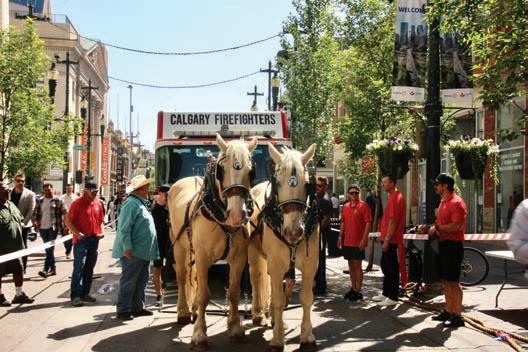


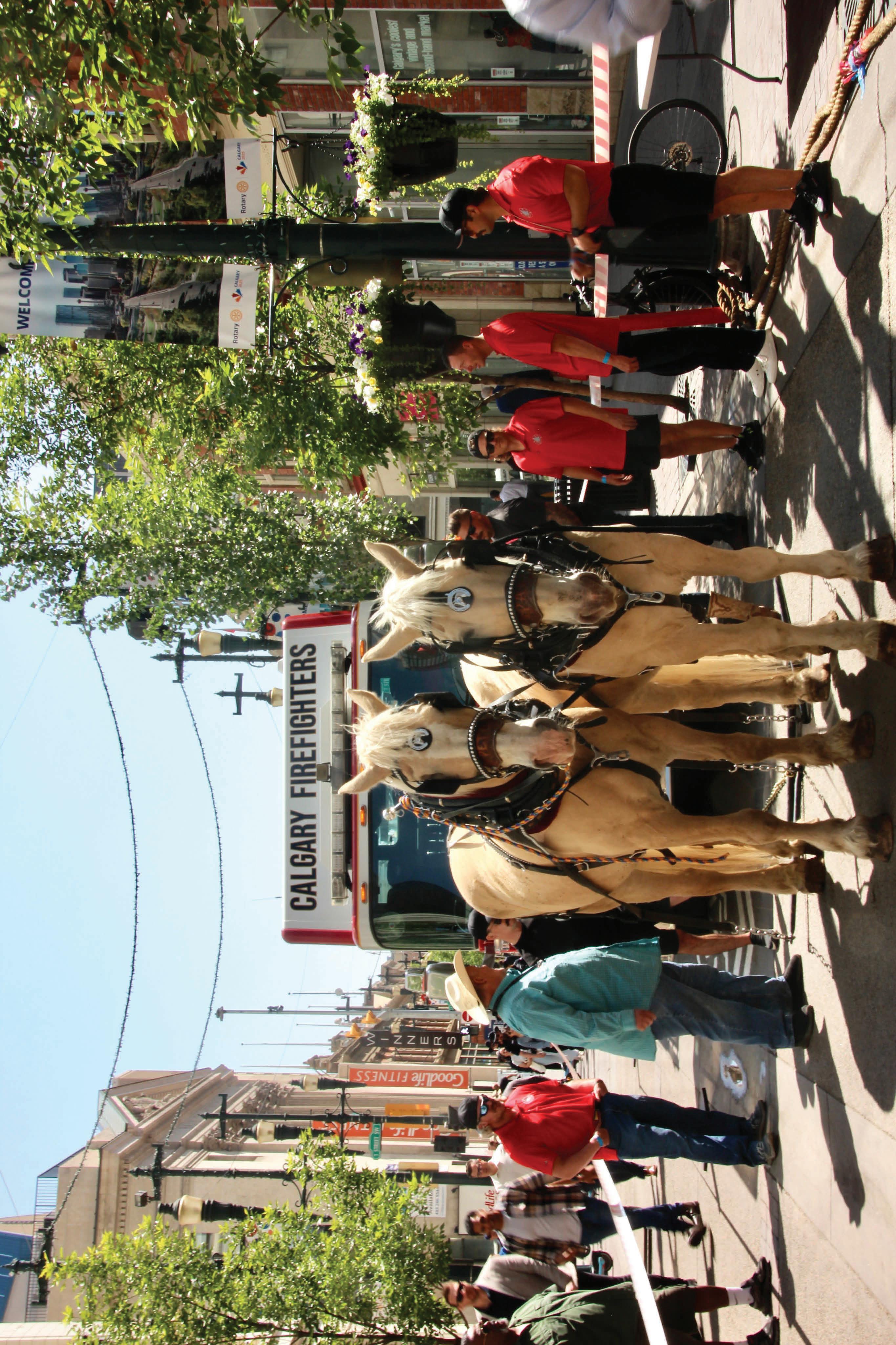


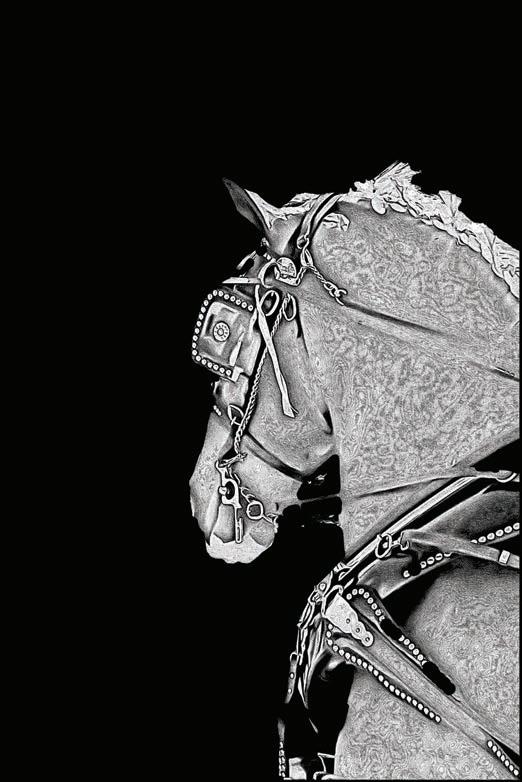



Your Building Needs Throughout BC! Why Fabric?
SpanMaster Structure’s Fabric Buildings are custom designed to safely exceed your site snow/rain/wind loads to protect you and your family, friends, livestock and equipment investments against loss. Even if you don’t need a building permit, you still want your investment to be safe and to last for decades, free from liability.
Fabric Structures are bright inside and quiet. Horses love the shadow-free environment making training and riding more enjoyable, year-round.
Fabric is a neutral, non-conductive material. It naturally warms in Winter daylight while cooling in Summer. Fabric does not absorb or radiate heat and cold like other common construction materials.




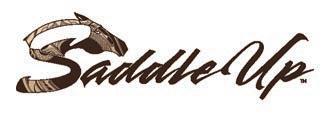
Executive Editor & Publisher
Tass Speer
Co-Editor & Design
Ruby Gerhart
Graphic Production & Design
Michal Kozlowski & Lindsay Lorraine
Writer & Marketing Strategist
Amber Zierath
Founder Nancy Roman
MAIN OFFICE
TOLL FREE 1-866-546-9922
ads@saddleup.ca hello@saddleup.ca
SADDLEUP.CA
MAILING ADDRESS
Saddle Up magazine PO Box 371 Armstrong, BC, Canada V0E 1B0
Published and Printed In Canada
Publications Mail Reg. No. 40045521
GST Reg. No. 751444159RT0001
ISSN No. 1701-6002
© All Rights Reserved
SUBSCRIPTIONS
$28.00 CDN plus tax per year or $42 US per year. (11 issues)
Reproduction of any materials without written permission from the editor is prohibited. Opinions and statements expressed in this publication are not necessarily those of the editor.
Funded in part by the Government of Canada.
Photo by Saif Patel
Britain Mills-Dawes, Amber Zierath, Laureen
James, Mad Barn Canada, Patricia E. Skinner, Amanda Enmark, HCBC, and Club News








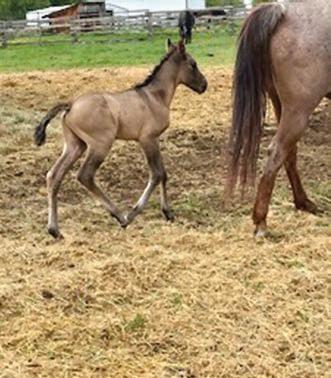









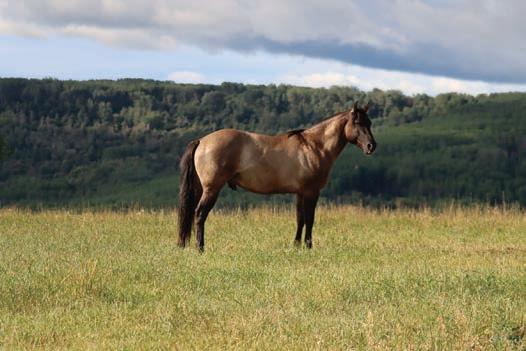









Percherons, Belgians, Clydesdales, and Shires.
ultimately your chances at winning.
These gentle giants are more than just showpieces—they’re athletes, partners, and living links to our agricultural heritage. What makes these competitions extremely unique to watch or participate in is the trust, partnership, and teamwork it requires from all the moving players. In this article I will be focusing on the obstacle course team driving class, explaining the history behind it and the patience and bond required to do it well.
Draft horses were used to pull logs, till and plow land, and help move large quantities that were too difficult or time-consuming to do by hand alone. These competitions reflect that by showcasing draft horses navigating a series of carefully designed challenges based on traditional chores. These challenges vary between competitions but usually include cones/poles, tight turns, backing up your teams, fanning, and other intricate manoeuvres that demand sharp mental focus and exceptional control from the driver and team themselves. To start, the competition is created with the past in mind. Back before machines became more accessible to farming operations, horses were the main modality used to help with farm chores and work.
What I myself find particularly fascinating is the team dynamics. There are so many partnerships that have to be forged to create a working competition team. Firstly, you have to have communication and trust between the human driver and their human helper; then there needs to be a strong bond between the two horses working together to pull the wagon; and lastly (arguably most importantly), the relationship between the driver and horse team itself. It’s an elegant dance of timing, focus, and intuition.
This isn’t just a spectacle of size and strength— it’s a showcase of obedience, training, and the deep relationship between driver and team.
A shining example of the spirit behind these events can be found at Draft Horse Town at the Calgary Stampede, one of Canada’s most beloved agricultural showcases.


This dedicated section of the Stampede grounds is all about celebrating draft breeds—their history, their strength, and their evolving role in today’s world. Visitors can not only learn about the different breeds' origins but can also see them up close and personal! All different breeds and colourings of these beautiful horses are brought in by owners for the public to see and interact with.




One of the highlights at Draft Horse Town is, of course, the driving competitions. Spectators get a front-row seat to witness these massive horses manoeuvre through obstacle courses with grace, precision, and undeniable power. Last year, I had the privilege of working closely with the committee and the Draft Horse Town team. What stood out most to me wasn’t just the majesty of the horses —it was the spirit of teamwork. From the volunteers and organizers to the drivers and their teams, there was a common thread: mutual respect, hard work, and shared passion for horses!
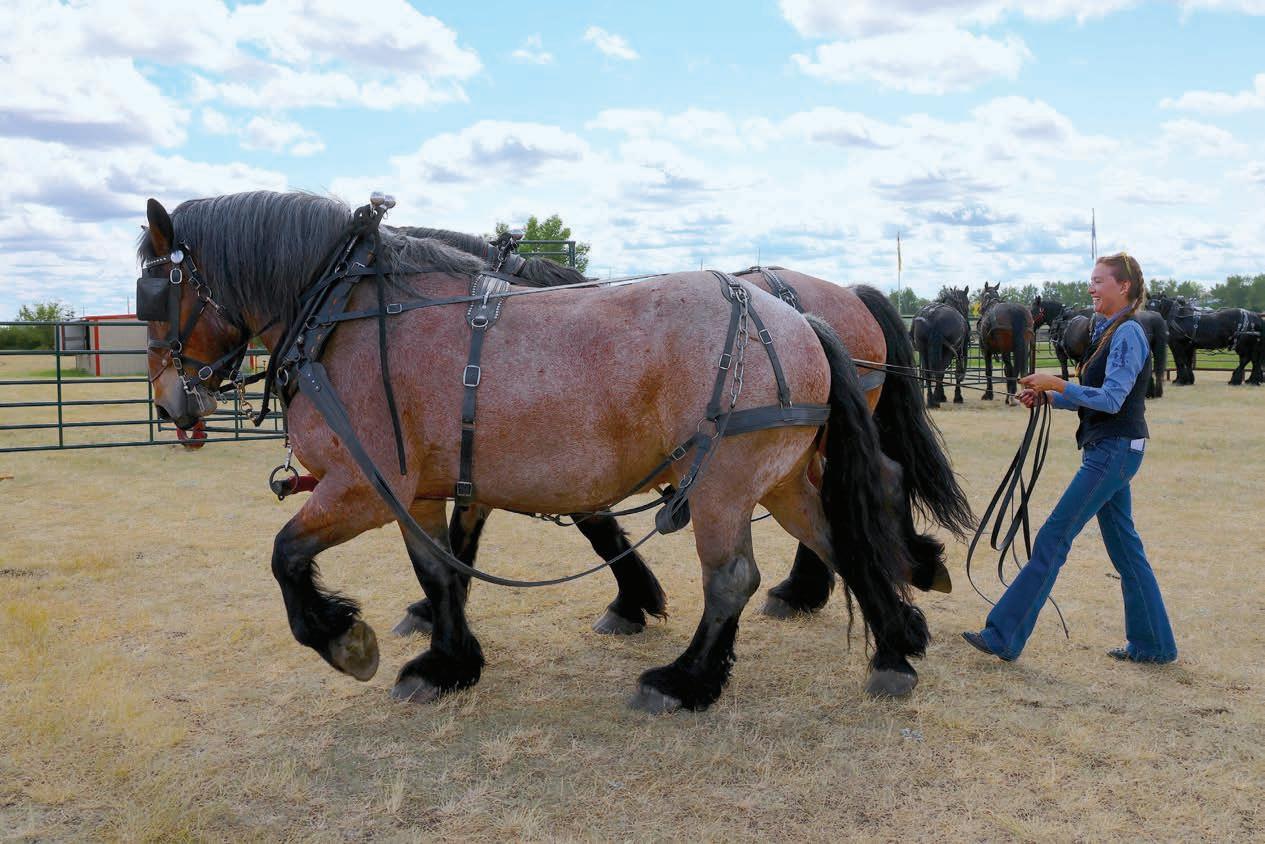
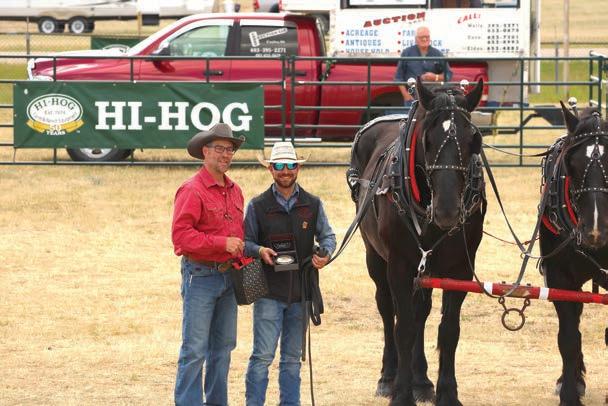
Team obstacle driving is more than a test of control—it’s a display of connection. Watching a team thread through a course with ease and elegance is a powerful reminder of what can be achieved when human and horse move as one. And thanks to committees like Draft Horse Town, that connection is celebrated, shared, and preserved for generations to come.
The camaraderie behind the scenes mirrored what we see in the ring with the different teamsters and persons in the committee. Everyone works as one to ensure the safety and ultimate enjoyment of the horses involved, their human counterparts, and the public who came out to experience what Stampede had to offer. It takes a village to run a competition and showcase the breeds on such a large scale—everyone involved, both horse and human, is working together toward a common goal. It’s a reminder that these events aren’t just spectacles; they’re communities built on trust, tradition, and teamwork.
podcast Uncinched. Connect with her at stableinstincts.ca - Photography by Britain Mills-Dawes

All set up for horses and animals!
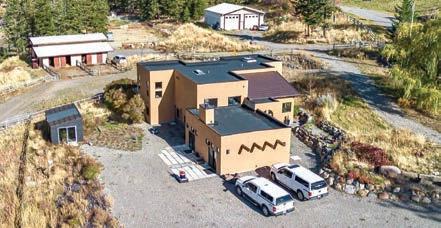
Located on quiet end of road, Erin Valley Crescent, Kamloops, BC, this 6.3 flat acreage has city water, drilled well, fenced and cross-fenced, and just 20 minutes from the city’s downtown core. Two-year-old 4700 square foot high-end home, overbuilt for modern convenience and comfort. Modern kitchen with high-end appliances, heated tile floors throughout, back-up electric furnace, central air-conditioning, copper bathtub, his and her copper basins, large & open walk-in tiled ensuite shower, plus many more features too numerous to mention. A 40’x50’ modern barn comes with 6 paddocks, has rubber flooring, heated office/tack room, and hot and cold water. Separate corrals and a first-class outdoor riding arena. Massive heated and air-conditioned 40’x50’ newer shop with 14’ high-powered doors – a trucker’s delight. Priced at $2,550,000.00. Information packages available upon request.
Albers
Kamloops
2,550,000 2363 ERIN VALLEY CRES. KAMLOOPS, BC
FEATURES
Water
Well


Heavy horses are worth their weight in gold. Throughout generations past, breeds falling into the draft horse category harnessed many of humanities visions. With willingness and drive to work, heavy horses have historically brought a range of concepts to fruition. At one point in time, people were reliant on them for warfare, farming, shipping goods, logging, mining, road and building construction, transportation, and much more. Today our reality and existence are different, and we don’t rely on heavy horses the way we once did. Some groups continue to honour traditions of days past, though. Utilizing draft horses to cultivate a sense of teamwork for other significance – joy and bringing people together.
With pioneer ploughs, antique cultivators and harrows, and more, Dale Befus of the Alberta Carriage Society (ACS) graciously hosts annual farming events on his property east of Calgary. Participants and volunteers come together with Dale’s Percheron horses and perform farming practices now lost to engine operated equipment. With teams of horses and humans, they seed a crop each Spring which involves ploughing, cultivating and seeding. When Fall hits, these teams come back together for the harvest. These events are special and has these traditional farming practices translating from one generation to the other, and with the public. “It’s exciting to watch young and old people having conversations in the field while working together,” says Dale.
These farming events have humans from different walks of life and varying ages coming together for a common good and a sense of accomplishment. It exposes people to a way of life they’ve never known nor could have without these events. At the end of the day, hearts are filled with a great sense of community. “There is magic in it,” says Dale. “The harvest is finished, and the wagons are full of a heavy load of barley. You’re rolling down the road and the horses are prancing along and the wagons rumbling.”
Away from the farm, these crews are busy participating in parades, back-country camping and logging. Cheri Hamelin plays an active role in all ACS events and is especially fond of logging with a team. This practice requires technical maneuvering in the forest, driving the team of horses whilst walking on the ground behind them. This activity requires unison between the horses and humans, which is exhilarating for Cheri.
“Heavy horses have given us so much power throughout history and it shouldn’t be forgotten or lost,” says Cheri. “It’s important for there to be an element within the community to remember all they’ve done.”

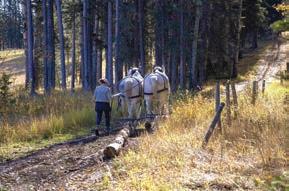



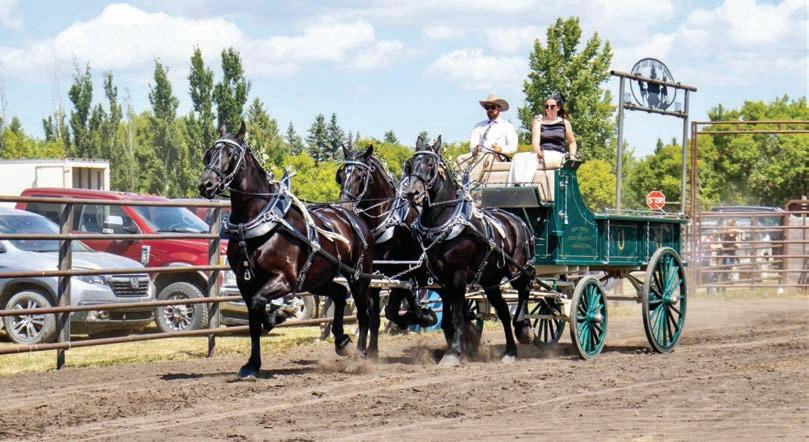


Last year, Scott Ferguson trained seventy horses. As a respected horse trainer and having experience working with nearly all breeds of horses, this is a common number of horses for him to train in a twelve-month period. Scott will work with horses of all ages; he once trained an 11-year-old Percheron stallion who was gelded at that age. “The older ones just take a bit more patience,” says Scott.
In the heavy horse division, Scott has trained and worked with virtually all types. He appreciates working with a draft because their personality is toned down – they’re so willing to work for you and willing to use their power. Training begins with a lot of ground/pen work. Scott incorporates some of Clinton Anderson’s techniques with heavy horses to a certain point, then it shifts to driving techniques which differ from that of light/saddle horses.
“When you use your horse, it increases in value. When you use your tractor, it decreases in value,” says Scott.
Scott has his own system for training heavy horses. He doesn’t do it the traditional way for draft horses - when he was a kid with his uncles, he would hook-up horses and run out of the yard at a dead run until they slowed down - this is considered old school. He currently lives in a valley with no place to run, so he had to adapt to new methods for training a team.
He finds success with putting a lot of miles on the horses when training. Scott’s property has ten miles of trails in the bush with hills, creek crossings and a busy gravel road bordering his land. He will hook four abreast with two veteran driving horses on the inner and two rookies on the outer then gets the horses out and moving. Scott finds this technique works well as the young horses easily follow the elder ones. Emphasis is placed on the horses responding to the driver’s body movement.
Aside from training, horses are woven throughout Scott’s life, including working with heavy horses on his farm in Minnedosa, Manitoba. He’ll hitch a team to do chores like cleaning out the barn, moving bales and rolling out hay for feeding. They participate in horse-drawn sleigh rides often, providing them for the town at Christmas time. Showing hitched teams of horses is a family pursuit. Scott’s son Cody and his girlfriend Casey are keen on showcasing the family Percheron in six-horse hitch divisions. This year, catch them at the Calgary Stampede in the heavy horse events.

Scott enjoys horses. He appreciates their unique personalities and how they’re all different. Working with a team is peaceful, there’s no motor running, and there’s a sense of self-sufficiency. The wheels could fall off the world, but you can still work with your horses. For more information, find Ferguson Horse Training on Facebook and connect using Messenger.
Article by Amber Zierath, a Calgary-based, equine focused writer and the author of best-selling fiction novel Horse Karma. When she isn’t writing, you’ll find her with the horses; riding bareback in the mountains or spending time with the 60 geldings that inspire her. Learn more at: www.amberzierath.com

farm, old-fashioned sleigh rides at Christmas time and weddings with wagons and carriages. Hosting visitors and sharing their passion of heavy horses is a joy they like to share. Their team of draft horses are adept to touring people on carriage and sleigh rides. Around Christmas time, their popular horse drawn antique sleigh rides have welcomed roughly 2,400 participants per year.
They’re often asked why they prefer having Clydesdales. Adam enjoys how curious and friendly they are and appreciates their willingness to do things. The location of Adam and Kelly’s farm is in Armstrong, BC, a place known for heat in the summer. Clydesdales are originally from Scotland, making this breed more acclimatized to cooler weather. These fair horses have been known to sunburn their noses if out in the sun too long. Kelly and Adam have adapted their farm to keep their Clydesdales cool and well shaded in the heat. Clydesdales are prone to attracting mites on their legs due to their long hair, so Adam oils his horse’s legs regularly to keep them away. When feeding his horses, it’s kept clean and simple – not a lot of supplements, good hay, oats, loose salts, clean water and as much pasture as possible.
When training a team, Adam believes that patience and consistency is key. Attune the horses to cues and timing so when two horses are put together, they understand what to do. Adam has started horses, from introducing them first to a halter before presenting a harness. “Be patient through the process of introducing harness equipment,” says Adam. “It’s important when starting your own team under harness to do little and often.” It’s advantageous to hook up young horses to a team of trained and older horses as they learn what to do from them.
Adam prefers working with a team for farm work because it’s quieter and there’s a joy in it. He uses a team of two to four Clydesdales and antique horse-drawn equipment for ploughing, harrowing, tilling, and seeding and harvesting oat crops. In the fall, they host a scotch tasting, open to the public, and do a ploughing demo. Their audience travels by horse-drawn carriage out to the fields where the event is set up. There they’ll unhook the teams from the wagons and hook them to the plough and let their guests run the handle on the plough as Adam drives the team. Learn more at: horsedrawnokanagan.com
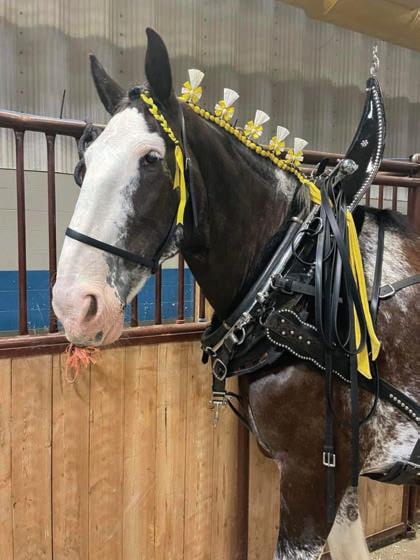


“The connection with the horses and having them all listening and working as a team is a neat feeling,” says Adam.
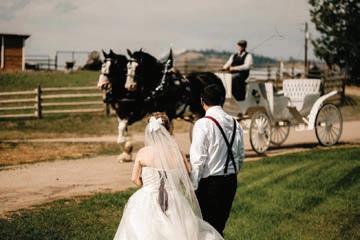







By Laureen James
Many riders struggle with cantering at some point in their riding career. Perhaps they are new to cantering. Maybe they just bought a new horse and haven't figured out their new mount's cues or sensitivities. Or, they have had a wreck, and their confidence is suffering. Sometimes riders easily overcome any fears associated with cantering, but sometimes the fear can be overwhelming. Thankfully, most of our fear is associated with fixable problems like more training for our horse, improving equitation skills, and having a better understanding of rider aids.
Clinton Anderson and Amelia Newcomb have years of experience helping riders and their horses to learn to canter or improve the canter while eliminating much of the fear or apprehension that can be associated with this gait.
Clinton Anderson established Downunder Horsemanship in 1998. The company focuses on teaching horsemen how to establish safe, fun partnerships with their horses and offers a comprehensive training library full of step-by-step guides to help all levels of riders reach their goals. Visit downunderhorsemanship.com to learn more.
Q: Why do some riders develop a fear of cantering?
From experience teaching clinics, it’s due to being paired with the wrong horse. It’s easy to get comfortable and learn how to canter on a horse that canters well. That horse will quickly build your confidence because you can focus on yourself. Plus, it’s fun. On the other hand, trying to learn how to canter on a horse that doesn’t canter well is a mess. If you’ve never cantered before and the horse is darting all over the place, racing around, or constantly breaking down into a trot or walk and you’re having to get after him, it’s really hard to get comfortable riding the canter. In some cases, it can be downright frightening.
Q: Clinton, in one of your podcasts you mention a colour system for personality typing. Does knowing personality colours help trainers and coaches do a better job when considering an individual rider’s needs?
The personality system is called The Colour Code. Knowing someone’s colour code is a good little guide but not an absolute to understanding their personality. Knowing a student’s personality and what is important to them definitely helps you as a trainer to guide them, motivate them, and help them get more out of lessons.
Q: Does unfinished horse training have an impact on how safe a rider will feel when cantering?
Yes, absolutely. If you’re a beginner rider, you need to learn how to ride on a well-trained horse that’s had thousands of miles at each gait. That way, when you get on him, he knows his job and is good at his job. If you’re both trying to learn how to canter together, it’s not going to go smoothly. A horse that doesn’t have much experience cantering needs an experienced horseman to guide him through the process. If you’re learning how to canter, the best thing you can do for yourself is learn to canter on a horse that canters well. Find a horse that will build your confidence, not wreck it. The ideal horse picks up the canter as soon as he’s cued to, he falls into a steady, rhythmic cadence, he travels a straight line and is easy to steer, and he stops as soon as he’s asked to. Too often, I see people trying to learn how to canter on horses that are barely broken to ride or have very little experience cantering. If you’re learning to canter, your horse is as well.
I can guarantee you’re in for a difficult time that will frustrate you and wreck your confidence. Think of gaining confidence in the saddle like riding a bike. How do you learn to ride a bike? You ride it, and ride it, and ride it. But you don’t just hop on and ride—your parents give you training wheels at first. Finding a horse that already knows how to canter well gives you those cantering training wheels.
Q: What skills do riders need to have, in the saddle, before they will feel comfortable at the canter?
Don’t try to canter until you are confident riding your horse at the walk and trot. You should be comfortable and balanced in the saddle, meaning you don’t grab onto the horse’s sides with your legs as he’s walking or trotting and don’t have a death grip on the reins or flop over his neck. If you’re not confident at the walk and trot, don’t move to canter. When you do canter, keep in mind that we all have to start somewhere. When you’re first learning to canter, don’t expect yourself to be perfect. You’re going to feel a little unsettled when you first ask your horse to canter. Getting comfortable and confident riding your horse’s three-beat gait takes practice.
Q: How does trot work prepare both the rider and the horse to have a great canter?
Practicing posting to the trot trains your body to move in rhythm with the horse. As a general rule, people who post are much better riders than those who don’t ever practice it. If you’re learning to post, I recommend practicing as much as you can for two or three weeks solid— or until moving in rhythm with your horse becomes automatic. The better you’re able to move with your horse and the more confident you are in the saddle, the easier it will be to canter your horse, and you’ll feel more comfortable doing it.
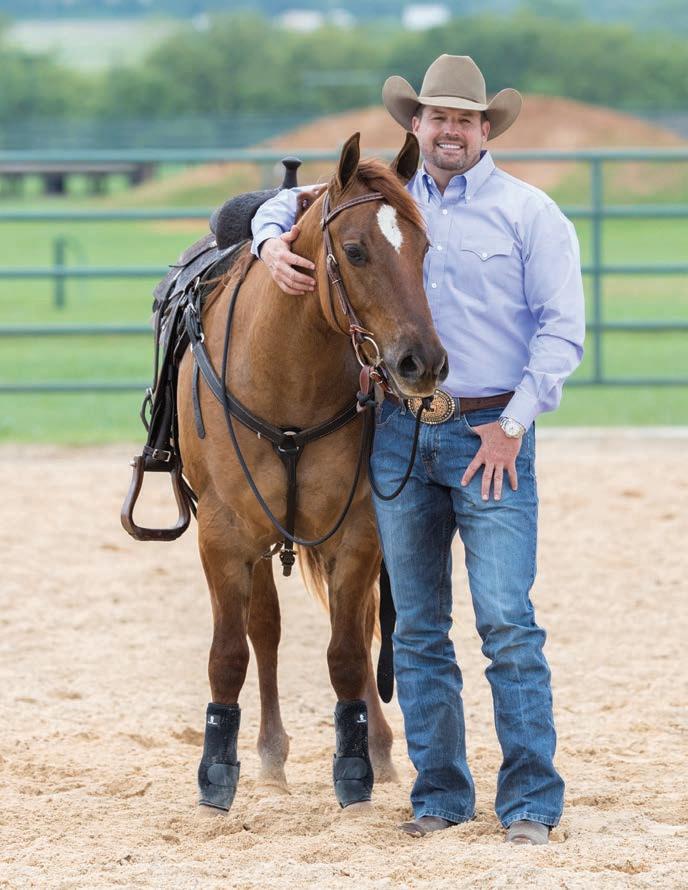
Amelia Newcomb is a USDF Gold medallist. Based in Somis, California, she incorporates complete dressage training from starting the young horse through FEI levels in both her in-person and online programs. Amelia works to develop a trusting and confident relationship between horse and rider. Her approach incorporates all aspects of horsemanship, from basic groundwork to advanced dressage movements. Amelia’s mantra has always been “Dressage for All,” which is evident in both her in-person and online coaching. With a successful YouTube video library of hundreds of educational videos, over 315,000 subscribers (and counting), and thousands of students enrolled in her online USDF-accredited courses.
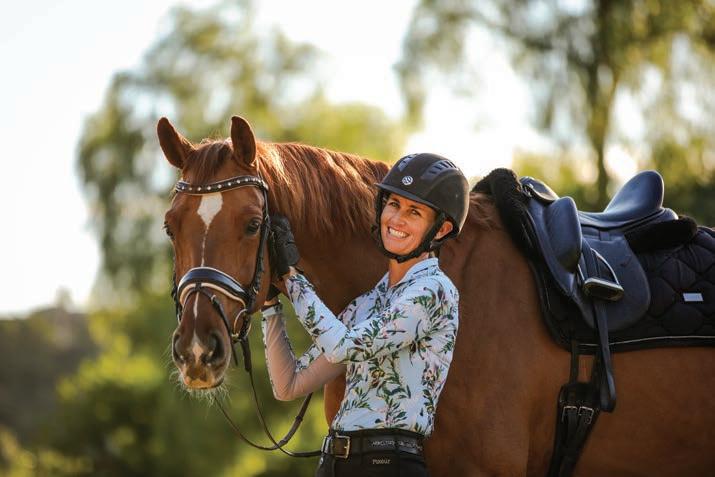
Q: When you were learning to canter, did you have any fear?
Oh, very much so! Growing up, all my barn friends loved to canter and wanted to jump, and I had fallen off so many times in my first year of riding that I had a fear of going fast. I remember one day I came home with blisters on my hands because I was gripping my reins so hard. Cantering took me a long time to understand and enjoy because it was such a big movement, but now it’s my favourite gait!
Q: Have you experienced any apprehension when cantering a fresh horse or a horse that has learned or enjoys bucking?
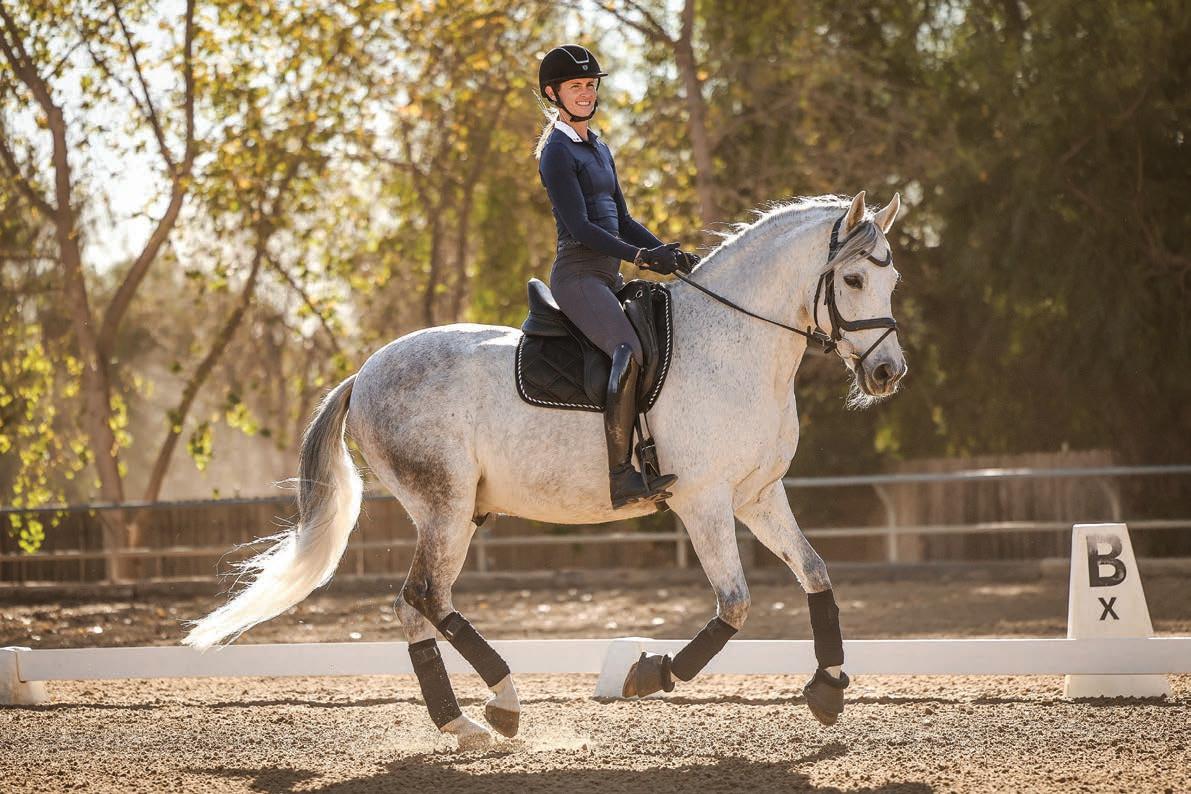
Q: At any time in your riding career have you struggled mentally or physically to ride the canter?
Yes, there have been a couple of times, but the one that sticks out is teaching my FEI horse Kensington how to manage his canter. When I got him at 5 years old, he had a MASSIVE canter. It was so hard to teach him how to engage and balance, and I remember thinking that I would never be able to teach him the flying changes. When you follow the training scale and use the exercises that will help your specific horse develop their body and posture, it works. Now, Kensington has an amazing canter, and he's been competing successfully in the FEI small tour.
Q: What advice can you offer riders who have a general fear of cantering due to the differences in rhythm or the feeling of more speed and power?
Two things: First, it’s to understand that learning to ride and control your horse in the canter actually makes you safer. If you never practice the canter and your horse spooks, you are a lot less likely to be able to sit it or stop your horse when they are in that new balance. This is the exact same reason you teach a cart horse how to canter—so they know how to stop safely when they are in that balance. Second, there are a lot of exercises in the trot that provide your horse with the balance and ride-ability you need in the canter. If you can master those, the canter gets a lot easier! I have 5 exercises that I focus on: Walk-trot transitions, 12m circles in the trot, adjusting the speed in the trot, posting to sitting trot, and cantering on the lunge line. You can learn more about the exercises in detail on my website: amelianewcombdressage.com, there I have available a free, downloadable PDF assessment and exercises to set you up for success in canter.
Of course. As a rider and trainer, I want to set both the horse and myself up for success. Before I even think about the canter, if I need to, I’ll get off and do groundwork to help the horse manage their mind and tension. In the ridden work, I have a series of systematic trot exercises to prepare for canter so that I KNOW what the horse will do in canter based off their reactions in the trot exercises. And to be honest, if the horse isn’t ready, I won’t canter until they are giving me the correct answers in the trot work while maintaining both their mental and physical suppleness. Only then can you start to develop confidence in the canter you have with your horse.
Q: Do you have a heartwarming story of a riding student that was very fearful of the canter and how you helped them to overcome their fear?
Honestly, if I have to help a rider ‘overcome their fear’ to canter, I feel like I’m doing my job wrong. It’s not about overcoming fear; it’s about understanding and mastering the elements that eliminate the fear at the root of the problem. Often times, a fear in the canter develops because a rider feels unstable or out of control in all gaits; it’s just that the canter is so much faster and bigger moving that it becomes more obvious that fear is there. When you slow down, go back, and teach a rider how to sit balanced, how to move with their horse through their seat, how the aids work, and give them the prerequisite exercises they need to master, often the fear goes away BEFORE we even get to the canter. This way the rider feels so much more established in their balance and understanding of the influence of their horse, and the canter ends up not being a big deal. That, to me, is the most successful thing I can do for my students.
There you have it! Some very usable advice from two very accomplished horse and people trainers. So, when you find yourself struggling at the canter as a newer rider or as an amateur with lots of canter miles but sudden apprehensiveness, try to figure out the root cause of that fear. Is it a horse training issue? Is it an equitation problem? Where can you seek out help? Confidence at the canter is always rooted in the basics of horsemanship. Master the elements of riding, and the fear of cantering will disappear, and the joy of this wonderful gait will appear.
Article by Laureen James BCom, Journalist, EC/NCCP Coach Certification IOB. Laureen is an equine journalist who writes for many publications. She also writes for the pet industry and is a columnist for Unison 50+ News. She has covered rodeos and related events over the past few years as a journalist and photographer.
To learn more about Amelia Newcomb, visit www.amelianewcombdressage.com and if you have questions, you can reach out to support@amelianewcombdressage.com.


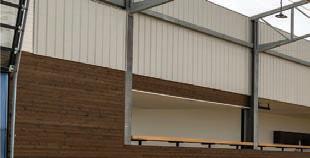
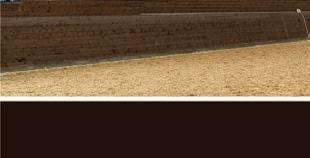









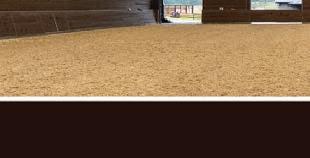











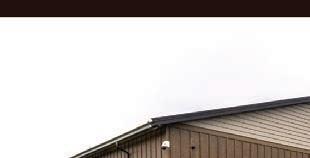






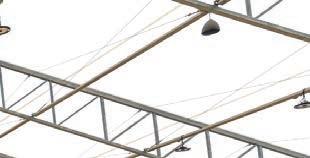


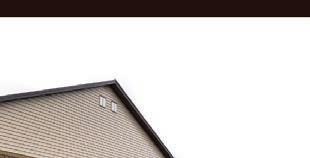






Gentle Giants Gentle Giants
hat can be said about the heavy horse breeds… While they have a dominating presence, impressive strength, and a large stature, they truly are gentle giants. Their large bone mass and powerful musculature set them apart; however, these attributes can present unique challenges in their dietary needs for energy and weight. Unlike lighter breeds bred for speed or agility, draft horses were developed for power, endurance, and steady labour. This purposeful breeding shaped not only their body composition but also their metabolic function.
Draft horses tend to have slower metabolisms, which means they burn calories more slowly than their lighter counterparts. From a survival standpoint, this was advantageous—it allowed them to maintain condition on less feed and work longer without needing constant refueling. However, in today’s world, where many drafts are not in constant heavy labour, this slower metabolism can become a double-edged sword. Caloric intake can easily outpace caloric expenditure, leading to excess weight, fat deposition, and eventually metabolic dysfunction.
Energy vs. Calories
Heavy breeds are often more efficient at storing energy than their lighter breed counterparts—great for survival, not ideal in modern feed-rich environments.



It’s important to understand the difference between energy needs and caloric intake, as they are not synonymous with one another! While they are often used interchangeably, they aren’t quite the same. Energy needs refers to the amount of “fuel” a horse requires to perform daily functions properly. This is influenced by many different factors, such as workload, life stage, weather conditions, etc. Caloric intake, on the other hand, is the actual amount of calories your horse is consuming through feed, forage, and supplements. Calories are the unit of energy provided by those feeds.
Here’s the issue—not all calories are created equal! Basically, a horse can meet or even exceed their caloric intake but still not meet their energy needs depending on the type of feed they are consuming. This is why it’s important to understand the difference and be able to make informed decisions on your choice of feed, forage, and supplementation. High-sugar grains and sweet feeds may deliver calories, but they also spike blood sugar levels and can lead to insulin resistance. Furthermore, fibre-based calories from forage or fat-based energy (like flax or oils) provide slower, more stable energy and are far more suitable for these heavy horses.
Speaking of insulin resistance, heavy horse breeds are more prone to this condition. For those unfamiliar with what it is, it’s a metabolic condition where the body struggles to regulate blood sugar levels due to improper responses to insulin. Over time, this can lead to metabolic dysregulation, laminitis, or even chronic fatigue and muscle loss.
The question still remains… Why are draft breeds more susceptible?
Speaking of insulin resistance, heavy horse breeds are more prone to this condition. For those unfamiliar with what it is, it’s a metabolic condition where the body struggles to regulate blood sugar levels due to improper responses to insulin. Over time, this can lead to metabolic dysregulation, laminitis, or even chronic fatigue and muscle loss.
Their larger size means their glucose metabolism differs slightly, and any dysfunction can be amplified by their weight.
Many well-meaning owners overfeed calorie-dense feeds out of fear their draft isn’t getting “enough,” when in fact they may be overloading their system with sugar and starch.
1 2 3 4
Base their diet on high-quality forage, not grain.
Avoid high-NSC (non-structural carbohydrate) feeds; look for low-sugar, low-starch options.
Provide slow-release energy sources like flax.
Many well-meaning owners overfeed calorie-dense feeds out of fear their draft isn’t getting “enough,” when in fact they may be overloading their system with sugar and starch.
One of the trickiest parts of managing a draft horse is distinguishing between a horse that is well-conditioned and muscular and one that is overweight. Muscles have a firm, smooth texture and a more symmetrical look to them. You’ll see it develop in specific areas such as the shoulders, top-line, and hindquarters where strain has been applied to the muscles with consistent work. Fat, however, often creates uneven lumps/dips or padding along the neck, shoulders, and/or tail-head.
Drafts, like ponies, are prone to developing cresty necks and fat pads along their withers, even when they appear “fit” at a glance. It’s also worth noting that obese horses can still be under-muscled! A lack of proper exercise and protein to build muscle can lead to bodies that store energy but don’t function optimally. Not just drafts, but any horse when they are overweight can experience more amplified issues surrounding their muscle function and work performance!
Long periods of too much weight can even lead to long-term health challenges such as these listed below.
Joint strain: Their sheer mass already places stress on joints—excess weight makes this worse, increasing the risk of arthritis or injury.
Heat intolerance: Overweight horses overheat more easily and can suffer in warm weather or during work. This can lead to excessive sweating and water loss, which can cause higher likelihoods of dehydration.
Laminitis: As insulin resistance progresses, the risk of laminitis increases dramatically, which can end your horse's career and be extremely limiting to your daily life if reoccurring, and is known to be extremely painful for the horse.
Start with forage: Grass hay is the safest base for most drafts. Avoid high-sugar spring pastures or rich alfalfa unless your horse is in heavy work or in need of higher protein and doesn’t have issues with insulin. Skip unnecessary grain: Many drafts do just fine with forage alone and may only need a ration balancer for vitamins and minerals.
Incorporate regular exercise: Even light work (like walking hills, groundwork, or pole work) can help maintain condition and prevent stiffness while helping with digestion. Movement for any horse, in any life stage, is extremely important to their health.
Track weight and muscle: Photos, girth measurements, and body condition scoring help you notice trends before they become problems.
Schedule vet checks: Have your vet out regularly and talk about metabolic testing and/or metabolic concerns, especially if you’re seeing cresty necks or chronic soreness and/or laminitis.
Caring for draft horses requires more than simply scaling up the feeding plan of a light breed—it means understanding their unique metabolic makeup and nutritional needs. With slower metabolisms and a higher risk of weight-related conditions like insulin resistance, draft breeds demand a thoughtful balance of energy intake and purposeful management.

To be clear, weight alone isn’t the enemy—but unmanaged weight, especially when it stems from excess fat rather than functional muscle, as noted above, can lead to a host of preventable issues that impact your horse’s comfort, performance, and longevity. Ultimately, it’s about honouring the draft horse’s strength without compromising their health while setting them up for long-term success.
While these beautiful horses with large frames are built for labour, their typically docile demeanour and lovable nature often make them great companion horses as well. So knowing how to care for their nutritional differences is important! With the right approach, they can stay strong, sound, and full of life for years to come.
Britain Mills-Dawes, owner of Stable Instincts—an equine wellness business specializing in bodywork and nutrition. She’s a practitioner, clinician, and speaker who’s presented at some of the largest Canadian equine events, such as the Calgary Stampede and Horse Expo. Britain also co-hosts her equine podcast Uncinched. Connect with her at stableinstincts.ca




Draft horses are heavy breeds originally developed for heavy farm labour like plowing and pulling carts. This guide discusses the history, characteristics, health problems, and nutritional needs of draft horse breeds. Keep reading to learn more about feeding and caring for draft horses.
Belgian Draft Horse
Clydesdale Shire
Percheron

Draft horse breeds are susceptible to unique health problems related to their size. Here are some common health problems: chronic progressive lymphedema, shivers, eye problems, respiratory diseases, and surgical complications. Common genetic diseases affecting draft horses are polysaccharide storage myopathy and junctional epidermolysis bullosa.
Examples of modern draft horses include the Auxois, Ardennes, American Cream Draft, and Suffolk Punch.
Draft
Most draft horse breeds stand between 16 and 19 hands tall. These horses have heavy conformations, with thick bones and muscular builds. Their shoulders are more upright than riding horses, which is more suitable for pulling. Their hindquarters are powerful and well-muscled. Most drafts have large heads with straight or convex profiles. Their necks are muscular, and their backs are short and broad. Draft breeds also have large, round hooves.
Coat colours and patterns vary significantly depending on the breed. Most drafts have solid coat colours, such as bay or chestnut. Excessive white markings are undesirable in some breeds but standard in others. Some breeds have feathering on their legs. Several draft breeds have traditionally docked tails, but the AVMA and AAEP advocate against tail docking due to welfare concerns.
Draft horses are known as gentle giants for their calm temperaments and kind dispositions. They have a willing work ethic and are typically friendly towards people.
Disciplines
Most recreational draft horses are used for driving. Some owners enter their draft horses in pulling competitions that showcase their strength. Some communities still rely on draft horses for agricultural work. Research suggests draft animals are still a sustainable solution for farming in rural regions.
As Canada's leader in equine nutrition science, Mad Barn thanks Saddle Up for featuring this story. To read the full version of this article, visit https://madbarn.com/draft-horse-breed-guide/
Draft horses should get routine preventative veterinary care, vaccinations, deworming, and dental exams. Regular hoof trimming by a farrier helps prevent excess loading forces from your horse’s large body weight on the lower limb structures. They often need more space than average-sized horses and are more likely to get cast in standard-size stalls. Ensure your draft’s housing and fencing are secure enough to contain a powerful horse safely. Breeds with thick feathering on their fetlocks are predisposed to developing pastern dermatitis from trapped moisture and debris. Thorough grooming routines can help support healthy skin and hair in these horses.
Nutrition requirements are determined based on your horse’s mature body weight. Heavier breeds, such as draft horses, have unique needs and require larger quantities of forage and commercial feeds compared to lighter horse breeds. Working with an equine nutritionist can help you formulate a balanced feeding program tailored to your draft horse’s individual requirements.
Most draft breeds are considered “easy keepers,” which means they can maintain their weight quite easily on a balanced diet. However, this efficient metabolism can predispose these horses to obesity if not managed properly. It can be difficult to distinguish obesity from the naturally heavy types of draft breeds. Body condition scoring can help you determine if your draft is a healthy weight and make adjustments to their feeding plan as needed.
The amount of forage your horse requires depends on your horse’s body weight, with heavy draft horses needing more hay than lighter breeds. A typical 2,000 lb (907 kg) draft horse is predicted to eat approximately 40 pounds (18 kg) of hay dry matter daily. Average-quality, low-starch grass hay is the best option for providing adequate amounts of forage without introducing excessive dietary starch. Once your horse’s diet is balanced, nutritional supplements, such as W-3 oil, vitamin E, and jiaogulan, can provide extra support for your draft horse’s individual needs.
“The
difference has been remarkable! ... My horse has shown improved stamina and is able to handle more intense workouts with ease”
-Christina M. Verified NOCR Purchase Review




Helps maintain healthy airways and lung function
Protects against seasonal respiratory challenges

Supports physical performance and cardiovascular health



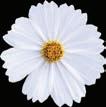

If you're anything like me, you can hardly wait to get into the dirt and enjoy some colourful flowers for your decorative boxes and gardens! My dogs often accompany me and help dig (sometimes way too helpful!), playing with the weeds and clumps of dirt and occasionally uprooting the odd plant or bulb, just for fun! While they seem to love their garden time (often to my dismay!), I always wonder in the back of my mind if I need to worry about what all they have nibbled on and whether I should watch for any resulting sickness afterwards. Most dogs love to dig in the dirt! Unlike prey animals, dogs, unfortunately, have zero instinct to know what plants are dangerous for them and what to avoid, and sometimes... curiosity gets the best of them when it comes to sampling buried treasures! Is what you're planting or hoping to enjoy in bloom this summer safe for your dog's excavations?
While stocking up and treasuring your beautiful flowering plants and bulbs, please be aware of the plants that can do your dogs harm if they take their playful adventures to a new level of intriguing snacks. Many bulbs and some flowers are toxic enough to make your dog sick to their stomach, make them lose their appetite, induce acute diarrhea, or cause excessive salivating, while others are very poisonous and can do serious harm to your dog if ingested. Note that if you know or suspect your dog has eaten a toxic plant, do not induce vomiting, as this may cause more damage—call your vet right away.
Flowers that are toxic and/or harmful for dogs (there are quite a lot!) Here is a quick sample list of just some of the plants and bulbs for you to review to help you keep your dog's gardening interests healthy, fun, and safe. DAFFODILS

Please make an extra plan to place these plants, flowers, and bulbs out of reach of your dog or protected from their access to them. Planting flowers in baskets out of reach, raised boxes, or adding a dog fence around your beautiful garden presentation may save your dog a lot of physical distress and you a vet bill!
Happy Summer!
Patricia Skinner-Porter is the owner/operator of Harmony Farm Kennel & Lamb at Monte Lake BC. Offering custom care boarding providing personal care, attention and daily exercise for ALL dog types, breeds and doganalities! Here she shares her vast array of experience with a beneficial monthly tip for you and your pooch to enjoy!

LILY OF THE VALLEY PANSY CROCUS PRIMROSE RHUBARB AZALEAS HYDRANGEA HYACINTH LAVENDAR MORNING GLORY CLEMATIS OLEANDER ALYSSUM
SWEET PEA BEGONIA CARNATION CANNABIS PINK DIANTHUS SWEET WILLIAM COLEUS CHRYSANTHEMUMS
COSMOS GARDENIA, GERANIUM FOXGLOVE MOST BULBS INCL. SOME TOXIC PLANTS
Wow! Philippé was busy this spring!! We travelled to Westlock Continuing Care to visit with staff and some residents in care. Then we took in a driving practice weekend at Sparrowhawk Spring Fling in New Serepta, where we learned about camping out, and Mom slept in the horse trailer! And finally we went to our annual driving club and long-ears open show! Philippé worked really hard and earned so many ribbons! It was busy, and we were tired! But it was so much fun!

EVERYTHING PETS in Princeton, BC 250-295-7381
Quality Foods & Supplies for all your pets! See us on FB
HARMONYFARMKENNELANDLAMB.COM
Monte Lake, BC 250-375-2528 “Custom Care” boarding welcomes ALL dogs!







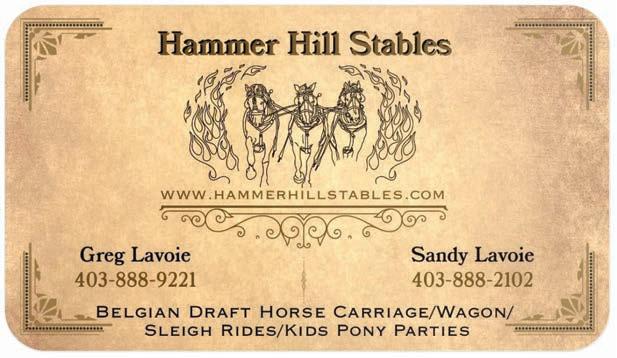






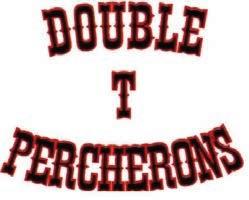




Mike Samis is a humble man who doesn’t care much for attention or having his picture taken. Thankfully, Mike enjoys chatting with people, which is fortunate, as this man is host to a treasure trove of knowledge. Most notably, Mike has a driving passion for sharing what he knows of heavy horses.
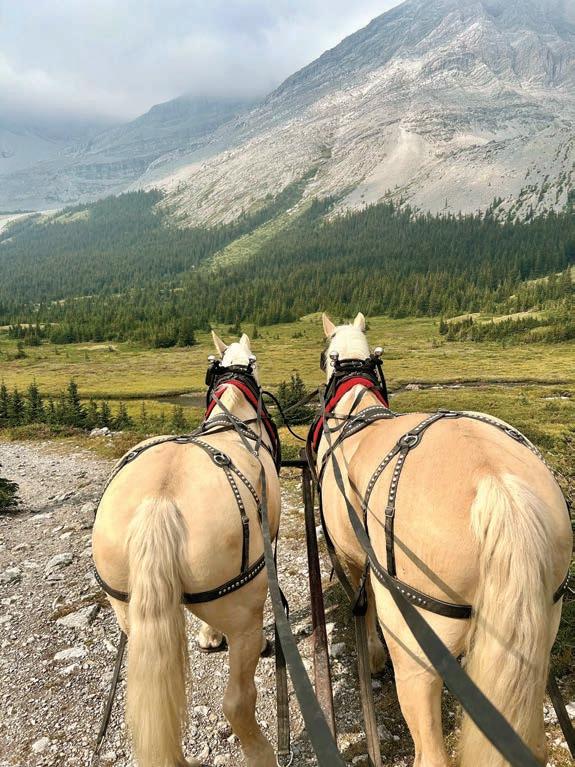
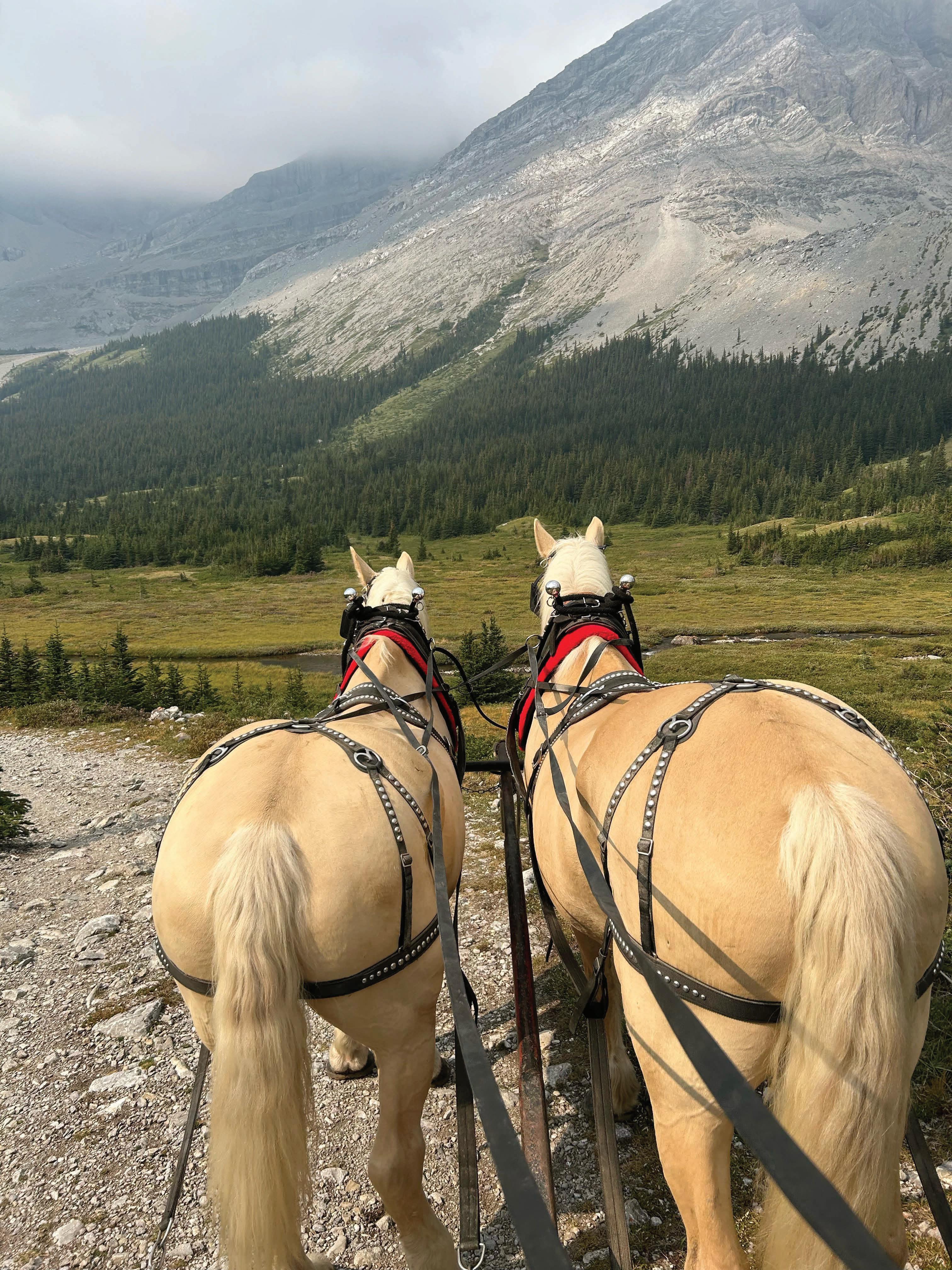
When listening to him speak of the breeds of heavy horse creating his herd, it’s clear he knows a great deal; however, he wishes to express that some of his knowledge is opinion, based on his decades of experience and research.
Mike’s introduction to horses came from his grandfather, a farmer of hay, wheat, and vegetables who didn’t use a tractor. Instead, His grandfather farmed with horses—mostly Percherons and the odd Clydesdale. Using teams of two, four, or eight, they plowed the soil, cultivated and harrowed the land, and seeded and de-weeded. This exposure to horses led to him becoming an equine enthusiast. “Up until about two years ago, I didn’t use a tractor to work my land,” said Mike. “The only reason being that I love working with a team of horses.”
Mike makes it sound simple to work with up to eight heavy horses at a time. Teams of horses harnessed and rigged together are managed two by two using two sets of lines for the outer horses and two sets of lines for the inner horses. They’re all hooked together, so when one horse turns, the others start to turn in the line. Working with a team of horses has a set of commands: "Gee" is to move right, "Haw" is for moving left, and "Whoa" is to stop. Everyone has a different method for moving a team forward, but commonly used phrases are “team walk,” “team get up,” or kissing sounds.
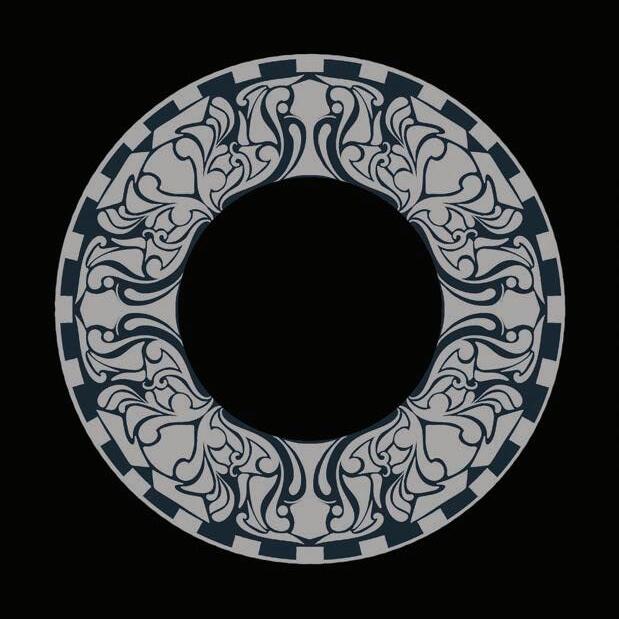

Next for the foal is a form of job shadowing—having them walk on the edge of an older, experienced, and working team. The harness is introduced around age two, but they’re not working with it, just learning how one feels on the body. The key for training a team of heavy horses is constant repetition. Mike's home is host to a diverse herd of heavy horses, one of few in Canada preserving some special breeds within this equine category. Fortunately, he is keen on sharing what he knows of these special breeds and how they’re unique.
Training a team of heavy horses begins at birth. Interacting with and imprinting the foal when they’re born has them acclimatizing to human interaction. Eventually, getting a halter on them and showing them lead basics like leading aids in developing their skillset early on.
For twelve years, Mike has generously shared his horses of these breeds willingly. Each July, he moves some of his herd to Draft Horse Town at the Calgary Stampede. Here they are open for the public to view and interact with, plus learn about. This section of the exhibition creates an opportunity to interact with a live animal.

“Some of my fondest memories of working with heavy horses happened at the Calgary Stampede,” said Mike.
“It’s exciting to watch little kids who’ve never seen a horse before come to the Stampede and interact with one. And new Canadians unfamiliar with horses—it’s fun to watch them interact with massive horses and ask questions.”

This heavy horse originated in Flanders, Belgium. The Brabant must have a roan body, neck, and head and black hair on its mane, tail, and lower leg. There’s variation of the roan colouring: red roan, bay, blue roan (dark blue and light blue), and black roan. The breed book for the Brabant began in the 1600s.
In earlier centuries, the ancestors of the Brabant were a man-of-war horse. Side Note: Most believe this man-of-war horse was large, but it was likely just 15 HH. In the 1600s most humans were short, likely just 5’ tall. Visual records perhaps depict a large horse in that time, as the armoured knights riding them were not tall.
The Brabant are easy to train, well-mannered, and nice to work with. They’re relaxed, sometimes too relaxed, as they tend to be less active, and their movements are quite slow. “Sometimes they barely have enough energy to get over the next clod of dirt,” says Mike of his own Brabant horses. The number of purebred Brabants is declining. In fact, Mike has most of the few Brabants in Canada.

The name of this horse comes from its place of origin in Suffolk, England. The “Punch” comes from an old English phrase used to describe someone stout. They are a calm, well-mannered horse and very easy to train. This is the oldest and rarest draft horse breed in the world. Because of the low herd numbers, Prince Phillip and Queen Elizabeth II started a trust for this horse. They kept a protected herd of Suffolk Punch on their estate and ran a breeding program to preserve them.
They stand around 16 HH and are always a chestnut (this isn’t a typo) colour, ranging from a dark liver variant to a light chestnut. The Suffolk Punch must be this colour with minimal white to be in the breeder’s book. This horse does not have feathers and has a white to whitish-brown hoof, which is small in comparison to other draft horses.
Both world wars took a toll on the Suffolk Punch breed, decreasing their numbers significantly. Their stout and well-muscled stature had them excel at pulling, which made them good for the artillery and ambulance carts. Presently, there are less than 800 in the breed book in the world. Mike feels fortunate to have some in his herd.


This heavy horse is known as a colour breed. These draft horses originally hail from the Northeastern United States —primarily Wisconsin and Michigan. They are the only draft breed of horse native to the United States. The origin story of this horse dates to the early 1900s.
Then lived a mare named Old Granny, and nobody of that time knew what her breeding was. She had amber eyes, pink skin, and blonde hair. Whatever horse they bred to Old Granny came out looking like her. It didn’t matter if she was bred to a Belgian or Percheron; her foals came out looking like the fair Old Granny, which formed a colour breed.
The North American Cream ranges in size from 15HH up to 17HH. People enjoy riding them because they’re not a wide horse; they’re stout. This horse is versatile; although driving, working, and so on. Mike is proud to have 16 North
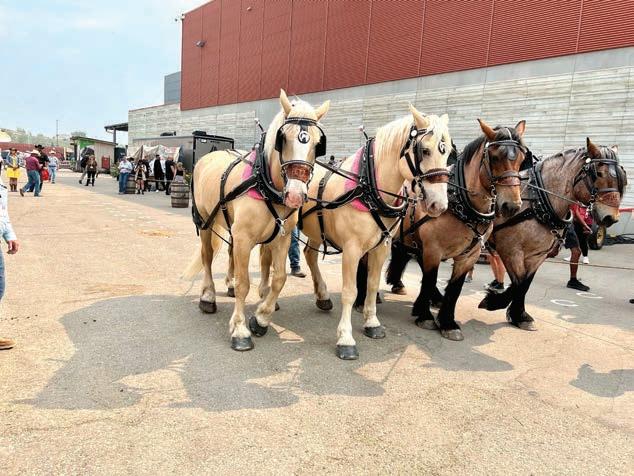
Ultimately, Mike states that working with horses is good for the soul. He has learned that a horse isn’t in a hurry, and it’s best to throw away the clock when working with them. A horse must trust you, and you must trust them. He has come to understand that what you put into a horse is what you’ll get out of it.

Can you tell us about your background and how it has influenced your art?
I spent 20 years as an aircraft maintenance engineer before an injury led me to the arts. I always enjoyed art but never practiced it myself until I was encouraged to by my wife, Cheri. My injury had left me bedridden with the loss of work and hobbies, and I was in a dark and depressed place in life. Cheri found an old set of oil paints one day while cleaning, threw them on the bed, and encouraged me to try it. I fell in love with it immediately, and it completely changed our lives. The two of us have worked together for over 15 years in the arts, with her managing me and the business and me doing the painting. As a thank you to her, I hide her name in every painting, so both our names are on every painting. We could never have kids and have always surrounded ourselves with animals of all types, including horses, and this really aids me in the accuracy and availability of subjects for my work. Cheri also works with draft horses through Alberta Carriage Supply, so we are immersed in the draft horse world on a daily and intimate basis.
Who are some artists or movements that have inspired your work?
I enjoy the work of Andrew Wyeth and find inspiration in the way he painted his neighbours and the landscape he lived in. My focus on my work is to create art from my day-to-day experiences living out in the country and being around traditional farming with draft horses, as well as the wheelwrights and Teamsters that are my friends.
What experiences in your life have shaped your artistic vision?
My grandparents had a farm in Manitoba, and growing up, many of my favourite memories are of exploring the farm and being around old antique equipment my grandfather had around. It was rough and rural living, but I loved being out there around the quiet and the animals.
What materials and techniques do you prefer to use, and why?
My paintings are all hand-drawn and painted using oil paints. Oil paints allow an elegance and quality of colour that is unique to them. I also have created many coins for the Royal Canadian Mint, and those illustrations originally were created traditionally by pencil but now are all done by hand using digital tablets.
Can you describe your creative process? How do you approach a new project?
I paint from my personal experiences, so the creative process begins by being out in the country with friends, farming, logging, and exploring the backcountry all by draft horse. I also create some historic scenes, and those are usually set up out on our property using our own covered wagons and antiques. My wife is often the subject of those scenes, capturing life in the 1800s. That allows me to capture my reference material that is later needed for study as I paint.
How do you choose the subjects or concepts you want to portray?
All my subjects are the animals, people, and lifestyle we find ourselves fortunate to live amongst.


What themes do you explore in your work?


My work focuses on rural Canada, both the lifestyle and the landscape and the people and the animals within it. A lot of my work with the Royal Canadian Mint focuses on historical subjects and portraiture, with some of my proudest work being the number of illustrations I have done of Queen Elizabeth II, both while she was alive and since her passing. While alive, the illustrations would have to go to Buckingham Palace to be approved by the Queen herself. A very surreal experience for me.
Is there a message or emotion you aim to convey through your art?
I try to capture the heritage and remnants left behind from our forefathers. I want to tell the story of their struggles and the challenges faced by those that are continuing in their footsteps, trying to keep those traditions alive.

What challenges have you faced as an artist, and how have you overcome them?
I am a self-taught artist, having never taken a lesson. There were many challenges faced early on and still today in trying to unlock the secrets to paint in my fashion. I spend every day honing and mastering my craft. Making a living in the arts is the biggest challenge, and one I couldn't have done alone. Cheri has played a massive part in our ability to make a living in the fine arts, learning how to show, sell, and market the work.
Q Q
How do you handle creative blocks or periods of low inspiration?
I live by the motto that 'inspiration is found through perspiration.' I find the only way to get through creative blocks or low inspiration is through hard work. When burnout eventually hits, I shift focus and work on other elements needed for our work. My hobby is restoring horse-drawn wagons and carriages, which make their way into the paintings, eventually.
In what ways do you think your work has evolved?
I push to improve with every brushstroke, and early on the work evolved fast. I focus on mastering technique over subject, and as such I have been able to train myself to paint any subject, whether that be landscapes, portraiture, animals, or any other thing that inspires me. My work with the Royal Canadian Mint has included an array of subjects, from historic tall ships and royalty all the way to planets and UFOs! Many that I would not have thought to create if not prompted by them.
Long Day In The Saddle
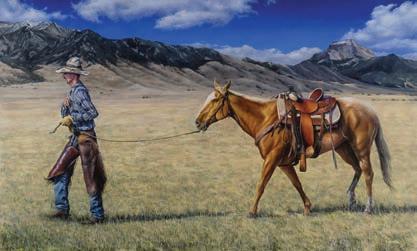
Do you have any rituals or routines that help you get into a creative mindset?
A I spend a huge amount of time in my studio painting 7 days a week, but I'm never alone, as I am surrounded by our animals and spend my breaks out with our horses or walking the dogs through the fields. I listen to a lot of audio books and podcasts. My paintings can take months to do depending on size, so finding ways to keep engaged yet not distracted is essential to help put in the hours.
How do you feel about the reception of your work by audiences and critics?
I love sharing my work, and it's one reason Cheri and I self-represent. Hearing the comments and the stories and memories that they trigger is humbling, and I love that people open up and share parts of their lives with me. Thick skin is required when making a living in the arts, and you have to separate yourself from people's comments and critiques of the paintings. In truth, though, I have been very fortunate and have met some of the greatest people in my life at art shows and can count the negative comments on one hand.
What are your goals for the future as an artist?
My goal for the future is to continue to create moments with friends and family and our horses that inspire my work. I am constantly pushing into larger shows and auctions in Canada and the USA to share my work with a growing audience.
How do you see the art world changing in the next few years, and how do you plan to adapt?
It is a very changing climate in the arts with the introduction of AI. It is having major negative impacts on traditional illustrators, but I have hopes that the fine arts will see a resurgence of sorts. I think we will get inundated with AI creations all around us, and the human pursuit will be celebrated. AI may create amazing imagery, but it can't replace the human connection and inspiration we uniquely receive being out in our world living our lives.
What role does art play in your life outside of your career?
Art is everything to me and my life. There is no moment in the day that is not somehow engaged with my creative pursuit. Making a living in the arts is a lifestyle over a profession. It is unbelievably amazing, and I can't believe my fortune to make a living that gives so much back in return.
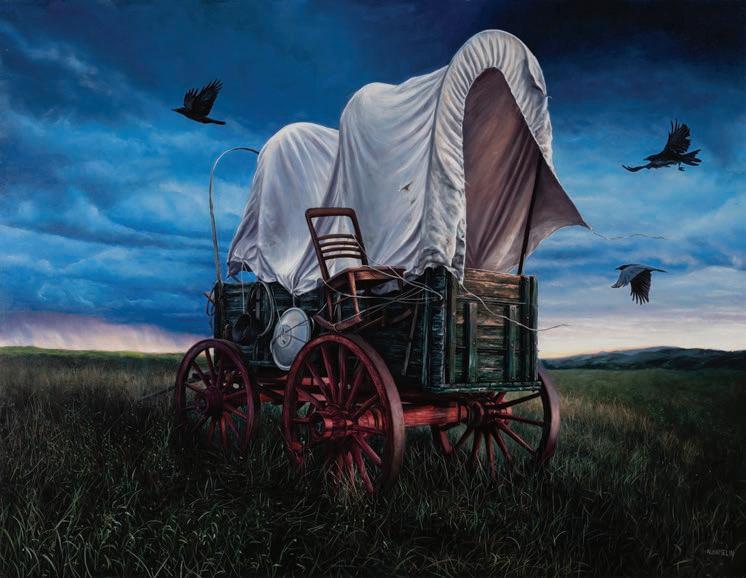

I'd enjoy spending an afternoon walking the fields and hills with Andrew Wyeth and listening to him talk about his inspiration.
If you could collaborate with any artist, living or deceased, who would it be and why? What impact do you hope your art has on others?
I like my work to be a touchstone, where the viewer can look at it and it rekindles a memory from their past, whether it be stories from their grandparents or themselves. A break in the day where the viewer can escape for a moment into another little world I've created for them.




Prairie West Northern Lights Show Thorsby, AB - workingeq.ca
July 5
Fast Eddy Fun Event
BC Carriage Driving Society Cobble Hill, BC bccarriagedriving.com
July 5-6
Mrs. T Horse Trials Maple Ridge Equi-Sport Centre, BC mrec.ca
July 5-6
Three Breed Classic Horse Show APHA, AQHA, APHC, All Breed Prince George, BC bcphc.com
July 5-6
SCQHA 5th Annual Ogopogo Open Kelowna Riding Club Kelowna, BC - kelownaridingclub.ca
July 5-6
Powell River Working Equitation Classic Powell River, BC workingeq.ca
July 5-6
Glacier Classic AQHA & All Breed Show Courtney, BC bcqha.com
July 11
YKnott Playday Canadian Cowboy Challenge Spruce Grove, AB canadiancowboychallenge.com
July 11-12
Mission Creek Ranch Derby & Dressage Kelowna Riding Club - Kelowna, BC kelownaridingclub.ca
July 12-13
Alberta Paint Horse Sunny South APHA Show Claresholm, AB bcphc.com
July 13
Buckle Series
100 Mile & District Outriders 100mileoutriders.org
July 13-15
International Development Seminar Aurora, ON workingeq.ca
July 15
Outriders Youth Night
100 Mile & District Outriders 100mileoutriders.org
July 17-19

Aug 27-31, 2025
Int’l Team Development Seminar workingeq.ca
July 18
Western Canadian Breeders Championship Show Thunderbird Show Park, Langley BC Tbird.ca
July 19
Turtle Valley Trails 2.0 Endurance Ride Endurance Riders Association of BC Chase, BC erabc.com
July 19-20
Carstairs Playday
The Canadian Cowboy Challenge Carstairs, AB canadiancowboychallenge.com
July 20
100 Mile & District Outriders 100mileoutriders.org
July 20
Outriders Gymkhana
100 Mile & District Outriders 100mileoutriders.org
July 25-27
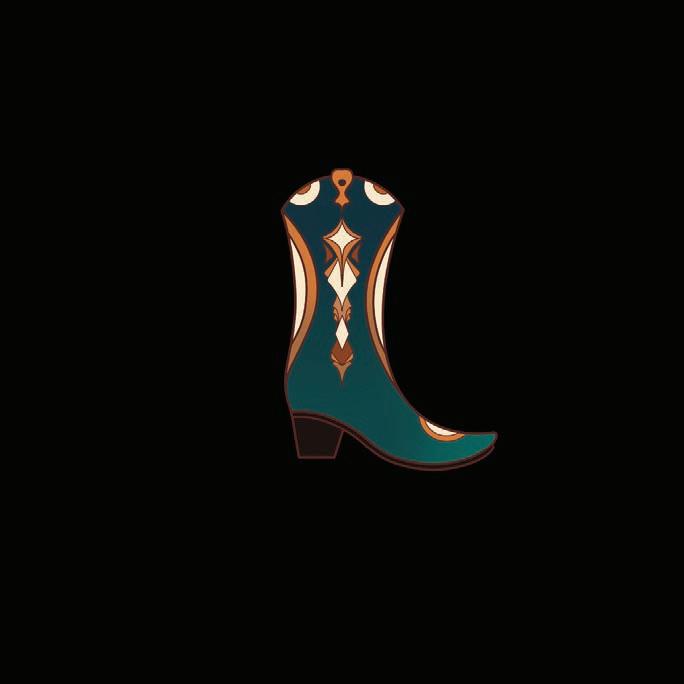
Light Horse, Heavy Horse, Miniature Horse shows. Armstrong, BC armstrongipe.com
Aug 29 - 31, 2025 Island 22 Horse Trials
Spruce Meadows “Masters” September 3rd – 7th
September 9-13, 2025 Nanaimo 2025 55+ BC Games
The Armstrong Enderby Riding Club Fall Show, September 27 & 28 in Armstrong, BC
Cariboo Country Dressage Series
West Coast Welcome-Lic. WE Show Langley, BC workingeq.ca
July 26-27
Horse Crazy Adventures Field Trial Petrofka View Ranch Roping Petrofka, SK canadianranchroping.ca

AERC the Armstrong Enderby Riding Club would like to thank the community for supporting us. This year the club has grown to over 90 members! Come ride in our next show and clinic with Jody Moore in September. Check our website armstrongenderbyridingclub.ca
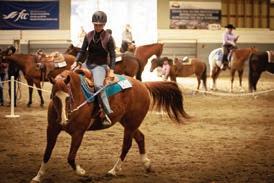




ne has to wonder what transpires to lead to a pony being on stage for 6 performances of Don Quixote with the Alberta Ballet. It takes a lot of good fortune, some coincidental connections, and taking a chance on a $50 pony.
I think my daughter, Ali, was 11 when she decided she wanted to try training a mini horse. I had recently purchased a mini donkey to train to drive, so I didn’t really have a leg to stand on to justify not making the purchase. A search through Kijiji found a promising little filly in Saskatoon, with a friend making a trip with her trailer along the route that could easily pick her up. It was kismet. Ali named her Jasmine, and so she became the best $50 I’ve ever spent on Kijiji.
One day, Ali decided it was time to start Jasmine in harness. She grabbed my donkey's harness, sorted it out, and put it on her pony. A short while later, I saw them ground driving. A bit later still, they were pulling a tire. That's pretty big steps for day 1! Wouldn't you know, before that weekend was over, that pony was hitched to a cart and took her first drives around the yard? No concerns. What a solid pony. Yes, I was impressed. This was definitely a good investment.
We started growing her exposure, taking her to shows and Die Herdt Greehouse and Bakery in Barrhead, and then we were asked to come to continuing care centres. That grew to invitations to a radio station, one of the best hotels in downtown Edmonton for CFR week, and countless other locations. Jasmine proved to be solid at every event, every step of the way.
I was scrolling through Facebook one day when I came across a letter posted on an Alberta Miniature Horse group from the Alberta Ballet. They were looking for a miniature horse who could pull a cart across the stage for an upcoming production of Don Quixote. Well, I knew a miniature horse who could do that! At that time, she was 7 years old and had even more experience in the world. I reached out to the ballet company. The company would be in Edmonton for their then-current production in March; would it be ok for the artistic director to come to the farm to meet her? I didn't want them to have to come out with rubber boots to meet shedding ponies... So, I offered to bring Jasmine and my donkey, Phillippe, to the Northern Jubilee Auditorium in Edmonton instead. I'm not sure who had more fun, us or Francesco Ventriglia, the company's artistic director. There were many pictures as we took the animals into the lobby area and met many of the company's dancers and building staff.



A day after our meeting, I received an email from the company inviting us to participate with Jasmine and work out logistics for rehearsals in Calgary. While everyone was taken with Phillippe, the logistics of 2 animals in the theatre and on stage were just more than the show really allowed for, so Jasmine got the job! The company was fantastic to work with. They listened to my concerns, provided me with everything we needed, and helped to ensure our wee friend's safety.
It was a Monday when we headed to Calgary and arrived at the Alberta Ballet's studio. It's a converted train station, right in the heart of Calgary. Although my nerves were worn getting my truck and horse trailer through traffic safely, Jasmine unloaded like she just woke up from a nap, calm, relaxed, and curious as ever. We unloaded her cart and harness, I put on her Cavallo CLBs, and brought her inside to meet the dancers.
I'm not sure what I was expecting, but I think thirty dancers were in that studio waiting to see her. She got to meet the dancers who would be handling her, had a walk around, listened to music, and then got in harness, hitched, and started working. Not once did she bat an eye or place a hoof (boot) wrong. She followed along as though she had been doing it her whole life. On Tuesday we went to the Southern Alberta Jubilee Auditorium to start rehearsals there. Again, Jasmine came in like a pro, looked around the stage, and then put on her harness, hitched, and went through her entrances like a pro! Wednesday was an all-day dress rehearsal, and Thursday was the final rehearsal and opening night! I was a bit nervous about her reaction to the audience, but there was never a need to be.

It was like she thought everyone was there to see her! She walked across the stage just as they'd practiced and waited with me in between, totally relaxed. That night she received her first standing ovation, and it was the first night I cried after the show (but not the last!). During the performances, I handed her off to the dancers just offstage and ran immediately down the hallway behind the stage to be able to catch her on the other side. I was not able to listen to the audience's reaction to her.
All the following performances were just as lovely. At the last show in Calgary, I hung back after sending Jasmine (sans cart) out with Yaroslav (Don Quixote) for bows and listened to the audience cheer and stand for her. After I walked around to the other side of the stage where she was waiting for me, I threw my arms around her neck, gave her a huge hug, and thanked her for being such a generous soul and told her how much it meant to me to be able to have this adventure and experience with her. Yes, I cried again.
We headed back to Edmonton, where we got a bit of a break before another rehearsal at the Northern Jubilee Auditorium. We brought a very special guest with us as rehearsal day landed on World Donkey Day! Phillippe came to visit, and everyone enjoyed having the little charmer backstage. Philippe and Jasmine wanted to celebrate the special day by bringing cookies for the dancers and the crew. It was extra for me because my daughter, Ali, came with us to help! The Edmonton shows were just as fantastic. The crowd is much more enthusiastic and electric “at home.”


I am so astounded by the generosity of animals. When they can find trust in the people around them and feel confident and curious, it's amazing what they will try for their people. Jasmine, a $50 no-name miniature horse from Saskatoon, is now a very accomplished mini who not only drives and competes and finds much success with her teenager but also warms the hearts of everyone she encounters, sometimes in the most interesting locations! I still say she's not exceptional; she was just given the chance to tell us who she is. And she is incredible!
Amanda Enmark is a self-described all-terrain equestrian. A dressage rider and AEF judge, breeder (standing LaBamba SE), former clinician for horse tricks and equine first aid, and now enjoys the adventures of carriage and combined driving with her miniature donkey Phillippé.
Ballet Photos taken by Nanc Price @nancpricephotography






Horse Council BC is excited to announce a new partnership with Perkopolis, offering our members access to a wide range of exclusive discounts and special offers. As an HCBC member, you can now enjoy savings on entertainment, travel, shopping, health & wellness, and more—just one more way we’re adding value to your membership!
Save on everyday purchases and so much more! This perks program is no-cost for you to start enjoying members-only offers today. Register for your Perkopolis account and find over 5,000 exclusive offers.
For information on how to register your HCBC number to your Perkopolis account:
login to your account at hcbc.online
under the “Me” drop-down at the top of the page, find the Member Discounts tab
We are thrilled to announce that the Horse Council Group Benefits Plan has hit a milestone—the first 50 live members! Open enrollment is currently underway and will continue until July 31, 2025. This is your opportunity to join the plan with guaranteed acceptance, no medicals, or pre-existing condition exclusions. Don't miss out on this chance to access a range of health, dental, and wellness benefits tailored to the equestrian community.
Key Dates
Open Enrollment Deadline: July 31, 2025
Eligibility: Open to all Horse Council of BC members
Ready to join?
Learn more & enroll: acera.ca/coverage/hcbc-benefits-plan
Office Hours
Monday - Friday
8:30 - 4:30 pm
1-800-345-8055
HCBC.CA
Provincial recognition may be granted to an HCBC member in good standing who applies for recognition and meets the published criteria. This coach may be certified/recognized by a number of organizations, including EC, CHA, Pony Club, Vault, CANTRA, or IGEQ. Recognized coaches may also be uncertified but recognized by experience, success, or other contributing factors. Recognized coaches may be on the pathway to certification.
There are many uncertified coaches in BC that are actively working with students as well as taking them to competitions. These coaches, for a multitude of reasons, are not considering formal certification.
To follow the principles of SafeSport and meet any upcoming viaSport guidelines for coaching and competition, HCBC is proactively creating a method of identifying and recognizing uncertified coaches. Any coach who is taking part in the Provincial Recognition program will have SafeSport training and screening that is at the national standard. With this, students, parents, and other stakeholders can be assured that the provincially recognized coach, although not certified, meets a provincial standard of screening.
HCBC would also recognize coaches who are certified by other agencies or disciplines and ask these coaches to also meet the Safe Sport standards.
The end goal is to have all BC equestrian coaches and instructors trained and screened in SafeSport principles and ensure that all BC equestrians have access to quality coaching. Coaches who already have files at HCBC with certifications such as CHA, Vault, or CANTRA will have the opportunity to submit the screening documents and be given Recognized Coach Status. They may choose not to submit the screening documents, and they will remain listed on the HCBC site, but they will not have the Recognized Coach logo or status.
Important note: HCBC Coach Recognition is NOT certification.
To find out more about becoming an HCBC Recognized Coach, contact Sarah at sarah.allison@hcbc.ca or hcbc.ca/coaching/horse-council-bc-provincial-recognizedcoach-instructor
Executive Director administration@hcbc.ca
Agriculture & Industry industry@hcbc.ca
Membership membership@hcbc.ca
Coaching and Education coaching@hcbc.ca
Marketing and Communications communication@hcbc.ca
Recreation and Trails recreation@hcbc.ca Competition competition@hcbc.ca
Community Development developement@hcbc.ca
HCBC Bookstore bookstore@hcbc.ca
Finance and Grant Funding finance@hcbc.ca
The CCC Challenge season is underway. It is still early in the season, so I think a reminder of the three Es is appropriate at this time. A CCC judge uses the 3 Es when judging a rider and their horse (the team) for each obstacle during an obstacle course.
Each obstacle in a course is judged on the three Es, and each obstacle is scored to a maximum of 10 points. As an example, the Shootin’ Sprouts division has 8 obstacles, so the maximum judges’ points is 80. Communication is a key aspect for the team to be able to navigate an obstacle and to complete an obstacle course. A smooth and effective presentation is based on how effective the communication process is within the team.

The foundation for communication is a combination of body language, hands, legs, and seat used in isolation or any combination of the four used by the rider. Body language is the confidence the team has in each other, which is transferred within the team through feelings. These feelings can be expressed through being relaxed, muscle tension, stiffness, or any other non-verbal methods. The hands are the direction and speed indicator (as well as the seat) within the team. With legs, there are (what I call) three buttons that control the front end, both the front and hindquarters (side pass), and the hindquarters.
The use of a leg button usually implies that the calf of the rider’s leg puts pressure on the horse’s side. The first leg button is just ahead of the cinch of the saddle, which controls the front end. The second leg button is at the cinch of the saddle, which moves the front and hindquarters in unison in the same direction. The third button is behind the cinch of the saddle, which moves the hindquarters. With the steadiness from the hands and leg button #1, a turn on the hindquarters is made. Again with the steady hands and leg button #2, a side pass is made. Again, with steady hands and leg button #3 used, a turn on the forehand is made. The seat is dependent on how deep the rider is sitting in the saddle. A shallow seat and steady hands from the rider indicate a faster pace is being asked of the horse. When the rider rolls their hip in a downward motion and with steady hands it indicates the rider is asking for a stop.
Communication within the team is a process and is the foundation in team building that should be part of the basics that the team consistently and constantly uses to refine and improve communication over time. It is an ongoing learning process. I have oversimplified what a CCC judge is looking for when scoring the team as well as the communication process within the team that the judge is scoring. But I think the better the relationship within the team more effective the communication, which enhances the presentation of the team to maximize their obstacle score.
By Hans Kollewyn, Photo by Sherry Ann Photography
BCTRA officially announces the speaker lineup for its inaugural Education Conference. Leading the Way, October 17-19 at Southlands Riding Club in Vancouver, BC.
The BC Therapeutic Riding Association has released the list of experts participating:
Keynote Speaker
Dr. Emily Kieson, PhD, MS, PgDip, ESMHL
Incorporating Equine Choice, Consent and Communication in EAS: Preliminary Practice
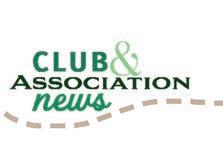
The Pen Obstacle used in competition is a round enclosure approximately 6 meters in diameter, with an inner enclosure of 3 meters, leaving a 1.5-meter corridor to ride through. Entry is made through a 1.5-meter-wide opening. Competition enclosures use panels up to about 1 meter high; for training, it's often easiest to start with poles on the ground.
In the Ease of Handling phase, the pen is ridden at a walk up to Level 3. From Level 4 onward, it may be executed in a walk or canter. A full execution includes a transition to walk just before entry, entering the pen in a chosen or prescribed direction, completing one full circuit, exiting, changing direction (via semicircle, turn on the haunches, or half pirouette), and re-entering in the opposite direction for a second circuit. If cantering, a lead change is also required. After the second pass, the horse exits and resumes its original gait.

The judge will be looking to give a good score for a smooth transition to walk and a straight, confident entrance into the pen. A calm, confident walk with good regularity within the pen, correct execution of change of direction, good reentry and second circuit, with a smooth quality transition upon final exit. Lower scores will be given for abrupt transitions, awkwardness, or hesitation. Serious faults include trotting, major resistance, rhythm issues, and errors in lead changes if cantering.
• Start by riding around the outside of the pen at a walk and trot.
• Practice exiting, changing direction, and re-entering once your horse is comfortable.
• Entering at a slight angle helps the horse see the path ahead, reducing hesitation.
• Before practicing the pen in the canter, ensure you can comfortably canter a 5-meter circle elsewhere.
• In practice, pick a default direction for your first entry (right or left) making it easier to remember your plan for competition.
• Stay close to the outside edge of the corridor to make it easier for your horse to stay balanced.
• Be aware that the inner enclosure is often decorated with fake or sometimes real small animals like goats, sheep, or chickens.
• In the speed phase, the pen is completed in only one circuit. Contact West Coast Working Equitation at info@westcoastwe.com for information on upcoming clinics and our annual Welcome Clinic/ Show, scheduled for July 25th to 27th in Langley.
By Vanessa Whittell, Photo Sandy Lang Riding
Victor
Teg Harper Rider Biomechanics
Patty Kirk Working with People with Neuro, Cognitive, Physical and Medical Diversities
Taylor Ormiston What Animal Characteristics Tell Us About Attachment Theory in EquineAssisted Services
Megan Pinfield ACEs Are Wild: Understanding the Effects of Adverse Childhood Experiences and the Developing Brain
Sandra Poppema How to Enhance the Welfare of Therapy Horses Through Positive Reinforcement
Karen Tanchak No More Burnout! Happy Horses and Engaged (Enthusiastic) Volunteers
Karinna Kenigsberg Propelling Purpose through Partnerships
Exclusive registration specials are available, including discounts on early bird rates and group discounts. The first 45 members to register will be entered into a draw for a $200 gift certificate. There are a limited number of seats available. Full conference details at bctherapeuticriding.com

Embrace your horse life

On a fine spring morning, the barn was in a controlled flurry. Several Vintage Riders ladies had a plan. We were registered for a clinic later in the month and thought a bit of pre-exposure to the venue would be a wise idea. The clinician had extended an invitation for those who wished to spend a bit of time at the set course on her property; a dry run is always advantageous. With synchronicity, we groomed, gathered gear, loaded, and rolled out.
All went smoothly until we arrived at the property. One of us saved some embarrassment when they were able to remember what the rest of us could not; the gate code! We wheeled our trailers in to parallel back in spots like the old truckers we are. Smugly we dusted our hands and unloaded quietly. Tied our horses with nets at the trailers. We had the cleanup tools with us for later. Wishing to be welcome guests another time. Looking around, I was happy we were doing this. Busy place…people, barns, sheds, many horses, dogs, cats, kids, trucks, wheelbarrows, and machinery in motion. All the things that set a horse on edge. With focused and calm moves, we got ourselves ready.
We stuck together and talked through our action plan as we made our way to the main arena. Very aware our horses were relying upon us for leadership and security. We paused a few times to let people and trucks pass, also allowing our horses to have a wee look around. After signing our waivers and receiving the protocol talk, we stepped into the sand. Sun shining, blue sky, breeze blowing, and each of us with our well-loved horses. And before us a tremendous variety of obstacles, pole patterns, gates, mailboxes, and decorated bridges—away we went. It was, remained, and finished successfully.
A free sharing of enjoyment in our comfort zone. Allowing us to recognize the significance of any small progress. With each encouraging the other, we set ourselves and our horses up for a relaxed and productive Ranch Riding clinic. With the Vintage Riders Equestrian Club, the following are a few upcoming, affordable events to help build your wellspring of grit. To push your boundaries is a learned skill. It serves well to pattern a calm, reliable response to adversity.
June 7: Yarrow Days parade
June 11: Club discount shopping day
July 1: Canada Day trail ride
Want to join us? Over 21? $42 a year. Meetings in Aldergrove, near the library. Door prizes. Guest speakers, great homemade snacks. A non-competitive, inclusive group who would welcome your knowledge and shared time to make things happen. Contact: vintageriders@mail.com
Feed and water your friendships, and hey… may the horse be with you!
By Kendra Kw
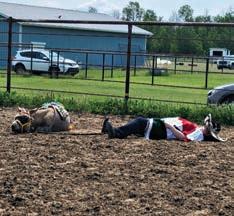





The May 31st - June 1st weekend was our annual ADMC Open Schooling Show held in conjunction with the Northern Lights Driving Club's annual Pleasure Driving Show. What a great weekend, despite the wind! We had the biggest turnout for the weekend so far, and it was exciting to see so much success for animals and their humans. Big winners this year were Brooklyn Bell and her mini donkey Pete, who won the high-point long ears driving championship on Saturday. Sunday's winners included Ali Preston and Phillippe Sombrero, who won the Junior Handler High Point LongEars championship. Melissa Glowinski and Jessica Rabbit won the high-point saddle long-ears championship, and Brooklyn Bell and Pete returned to win the all-around high-point championship!
Big thank you to The Creative Daughter for bringing her beautiful garments and a mobile store setup for the weekend, as well as donating two chore skirts to give away! They were drawn from participants who did not win championships. Amanda Enmark won from Saturday's group and Shaylin Exshaw from Sunday. The weekend was busy, a lot of work but made so much fun by great judges, volunteers, participants, and, of course, our 4-legged friends!
For more info on ADMC or to join, check us out at AlbertaDonkeyandMule.ca
BC Paint Horse Club held its 3rd annual Mountain Trail fundraiser on June 6-8, 2025, to raise funds for Kamloops Therapeutic Riding Assoc. and BCPHC. Organized by Rhonda Kopp, we raised over $4800 this year! 38 participants and 42 horses enjoyed the fabulous weather and fun activities, with 76% being previous attendees. From trail rides and playing in the river to paint night and a trip to Cider House for the silent auction, our saddle pad winner was Kelly Allen! There was something for everyone to have a fun and stress-free time with their horse.
Exciting plans for some new activities are in the works already for next year. Next year's Mountain Trail fundraiser is June 5-7, 2026, at Canoa Farms. Registration will be in January, and it usually sells out by noon.
A big thank you to our sponsors:
The Horse Barn, Kamloops Large Animal Vet Clinic, Home Hardware Kamloops, Pacific Coast Heavy Truck, Cangas Kamloops, Canadian Tire Kamloops, Ada Mogge, AquaPure Kamloops, Douglas Lake Equipment Kamloops, Mia Riback, Canoa Farms, Backcountry Horsemen Kamloops.

Submitted by Sarah Wolfe Alberni Valley Chapter




Even though I belong to the Alberni Valley Chapter of the Back Country Horsemen of BC, and trail-riding/trailclearing work bees are basically our main directive, I have felt for some time that putting on a “drill team” clinic for our club seemed like a pretty sound idea. I brought it up at our January ’25 meeting. The idea was well-received, and due to the positive feedback, it then fell to me to begin planning this event!
So ... what were my reasons and logic for voicing this objective? Well, I believe that such an exercise teaches many aspects of horsemanship to both horse and rider. Focus, agility, balance, discipline, work ethic, and lastly, the importance of the ability of a horse to work with a group of other horses in a scenario where, maybe, they have never even met one another, or, at best, only had the chance for an occasional connection. All characteristics that translate into indispensable qualities necessary in a sound, steady, sensible, and safe trail horse.
I also believe horses get bored; thus, mental stimulation is a good thing. There is a sense of importance or empowerment, a sense of “being useful.” How many of us have witnessed their horse have an “ah-ha!” moment? I often see traits in mine that remind me so much of the personality of young children: they want connection, they show trust and willingness to cooperate, and if you have that special connection with your horse, it is so evident they want to please and that they seek approval.
Back Country Horsemen of BC – serving
Once it was made clear that there was interest for such a gathering, I contacted a lady in Errington by the name of Jodie Bater... an expert on drill team instruction and “pattern-calling.” The event was booked for Sunday, March 22nd, at our local West Brook Stables and Equestrian Centre. There were seven of us with our horses, and other club members came to audit. Jodie did such a great job of introducing us to the nuances of “drill,” and I think we were all impressed with the way our horses handled it. Three hours of not only physical exercise but also constant mental stimulus is a lot for any horse to take in, and these horses mostly did not know each other. Another aspect, pointed out by my long-term riding buddy and friend, Lori-Ann MacLeod, was that although horses are used to going forward, either beside or behind other horses, ...the prospect of having horses one by one coming straight at you, either fast or slow, can be threatening if they are not accustomed to it! It is not normal behaviour, for instance, in a herd, unless a herd member is taking an aggressive stance. These are things we don’t often think about, or we take it for granted that our horses are used to it and will be OK with it. Something to take into consideration.
With Jodie’s guidance and expertise, we learned a lot that afternoon. How to work in patterns with our own horse, in pairs and within groups. How to lead, how to follow. Riding with a partner down a centre line. Circles, weaving, splitting to left and right, moving on the rail and back to centre, plus patterns like the “donut” and “peel the apple.” Drill Team Boot Camp! And our horses were all amazing!
From all of us who participated, a huge thank you goes out both to Jodie Bater and also to Chris Neville, owner of West Brook, who made it possible to use the huge covered arena and gave us such a great deal. Also, thanks and appreciation to Horse Council BC for their generous support. Here’s hoping we can continue along this path. A great learning experience for all.

Promoting equine activities and knowledge in the south Cariboo with Shows, Clinics, Gymkhanas and more. President: Danita McLaren
E-mail: 100mileoutriders@gmail.com ~ www.100mileoutriders.org



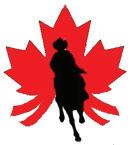


Welcoming a diverse equestrian community by fostering an environment of enjoyment, development, and competition. More details and dates available at kelownaridingclub.ca 3745 Gordon Drive, Kelowna BC


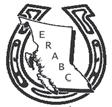
Watson, President • 403-378-4323 cbwatson@cciwireless.ca
BC CARRIAGE DRIVING SOCIETY
Pleasure, Combined, Recreation from Minis to Drafts, bccarriagedriving.com 824
BC PAINT HORSE CLUB
bcphc.com, Open Show & Competition Program, award sponsorships for local clubs, youth scholarship. cathyglover@telus.net 426
BC QUARTER HORSE ASSOCATION
bcqha.com Contact Carolyn Farris, email: cfarris@telus.net 325
CHILLIWACK RIDING CLUB
Drill Team, Horse Shows (Heritage Qualifiers), Gymkhana, Trail Rides, Clinics, Open Ride, Socials, crchorse.ca 325
INTERIOR CUTTING HORSE ASSOCIATION
ichacutting.com. New cutters always welcome. email ichacutting@hotmail.com 1124
LOWER MAINLAND QUARTER HORSE ASSOCIATION
Pres: Tamara Jameson, tamarajameson@hotmail.com, bcqha.com/index.php/LMQHA 325
NORTHERN SADDLE CLUB
Smithers BC. Check out our website at northernsaddleclub.com and follow us on Facebook 425
SOUTH CENTRAL QUARTER HORSE ASSOCIATION
Host of April Fuzzy Horse Show and September AQHA Circuit Show, bcqha.com/index.php/scqha 325
VERNON DISTRICT RIDING CLUB
(Vernon BC), check out our website at vernonridingclub.com or visit our Facebook & Instagram pages 326
VINTAGE RIDERS EQUESTRIAN CLUB
(Fraser Valley BC), English/Western, lectures, clinics, socials, safe and fun, vintageriders@mail.ca, on Facebook 626
WILD ROSE DRAFT HORSE ASSOCIATION
www.wrdha.com. Barb Stephenson (Secretary) phone 403-933-5765 (8:00 am to 8:00 pm)





BEDDING, HOG, FUEL, SHAVINGS
REIMERSFARMSERVICE.COM (BC Interior) 1-855-737-0110 or 250-838-0111. Bulk Shavings, Sawdust, Bark Mulch and Hog Fuel. 4x4x4 Shavings Totes 326
EQUINE FIRST AID
EQUUSOUL EQUINE FIRST AID Courtney Gledstone 604-838-1182
Equine Emergency First Aid courses available for all ages & ability levels, CE credits avail. FEED DEALERS
ASHCROFT HOME BUILDING CENTRE (Ashcroft) 250-453-2281 Otter Co-op Dealer & Pet Foods. You can find us on Facebook 326
HORSE BLANKET & REPAIR
HORSE BLANKET & SADDLE PAD WASHING & REPAIRS Clean used Blankets for sale Town Centre Dry Cleaners 250-546-0104 Armstrong 725
TRAILER REPAIRS
PETERSEN TRAILERS LTD. (Langley) 604-533-4209 Service and Repairs. All makes. petersentrailers.ca 924
TRAILER SALES
KITT EQUIPMENT TRAILER
SALES, (Chilliwack & Aldergrove), 1-877823-7199, Horse ~ Stock ~ Utility ~ Dump ~ Flatdecks
Kittequipment.com 625
STALLIONS & BREEDERS
APPALOOSACENTRE.COM
250-963-9779 Real Appaloosas for Today and the Future! 924
VETERINARIANS
ANIMAL CARE HOSPITAL
Williams Lake 250-392-5510
Quesnel 250-747-3053
Drs. Magnowski, Scheidt, Thompson, Jordan, Deitrick, Johnston, Wurzer 625
CONNECT VETERINARY SERVICES (Okanagan) 250-212-3513 Mobile Equine, Dr. Savannah Beavers, connectvetservices.com 326
INTERIOR VETERINARY HEALTH
SERVICES (Okanagan) 250-863-5996, Mobile Equine, Brytann Youngberg DVM, VSMT, College of Animal Chiropractors 326














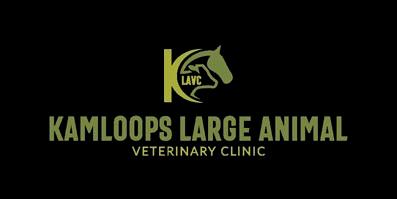

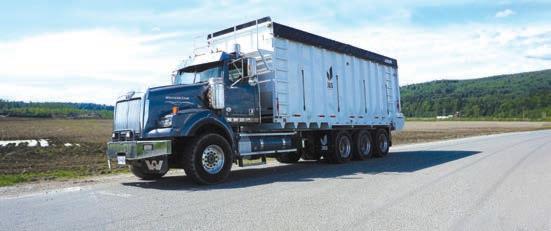







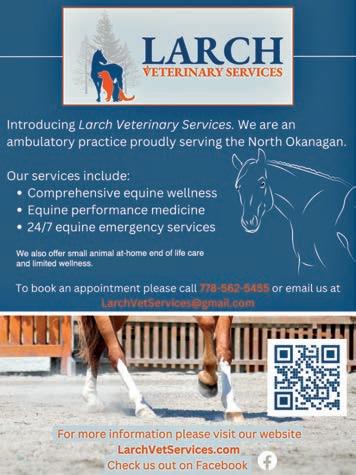
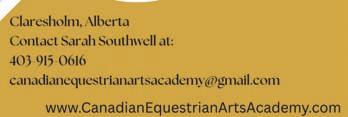









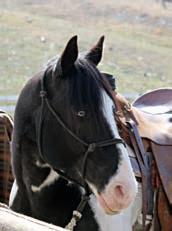









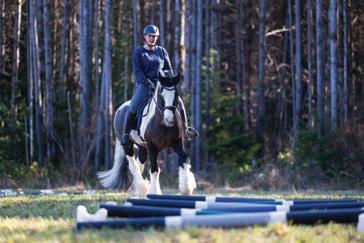



mission is to make premium, maintenance-free equipment more accessible to Canadian riders.



